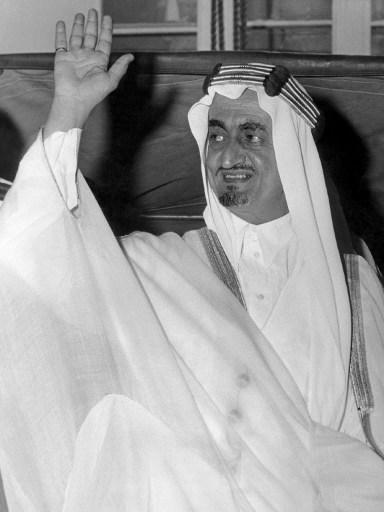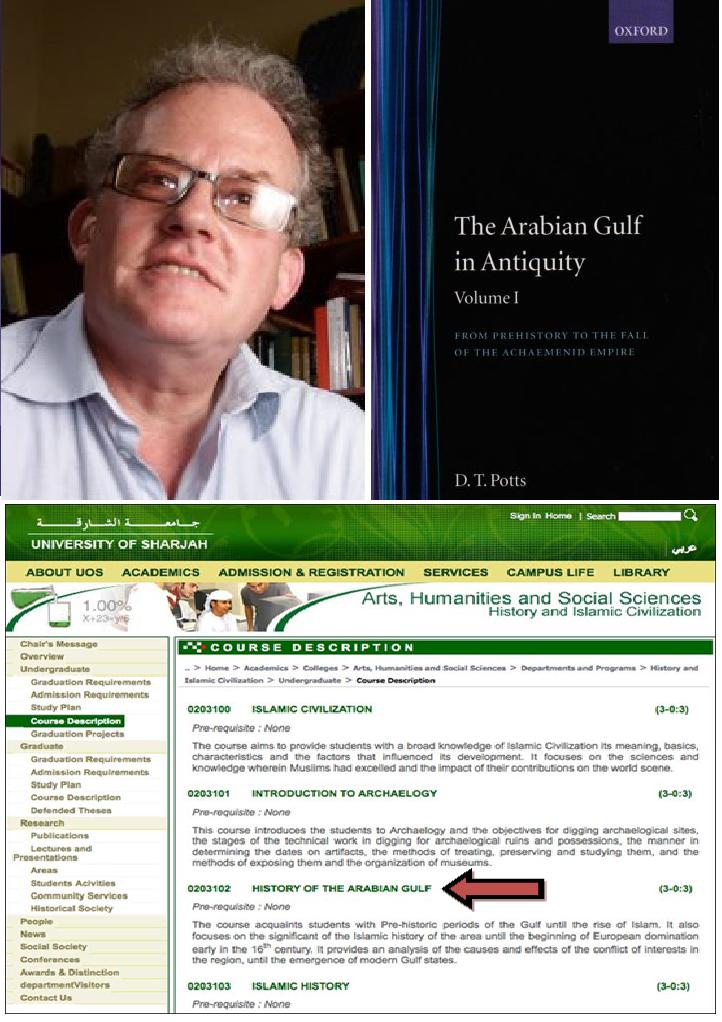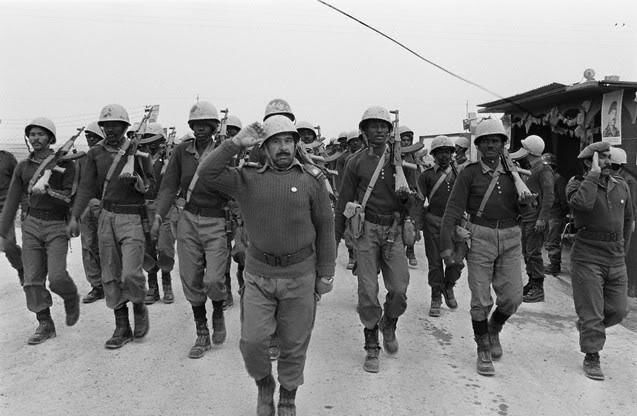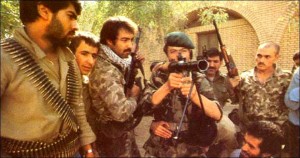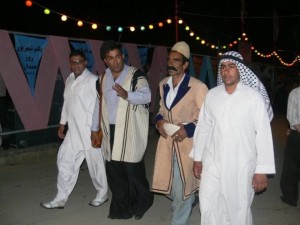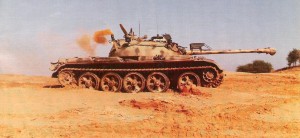This article was originally written by Kaveh Farrokh in 2004. The article has undergone several revisions on Kavehfarrokh.com with the latest on July 4, 2016 (original 2004 version available in pdf). An academic version of this article (in Persian) was first published in 2004:
- کاوه فرخ (۱۳۸۳/2004). میراث پان عربیسم. اطلاعات سیاسی-اقتصادی, شماره ۲۰۹-۲۱۰, صفحه ۴-۱۵ – Farrokh, K. (2004). The Legacy of pan-Arabism. Ettelaat Siyasi-Eqtesadi
[Political-Economic Information], Number 209-210, pp.4-15.
More recently, a second and newer academic article on pan-Arabism by Kaveh Farrokh has also been published in the Palgrave-macmillan Encyclopedia of Imperialism and Anti-Imperialism in 2015:
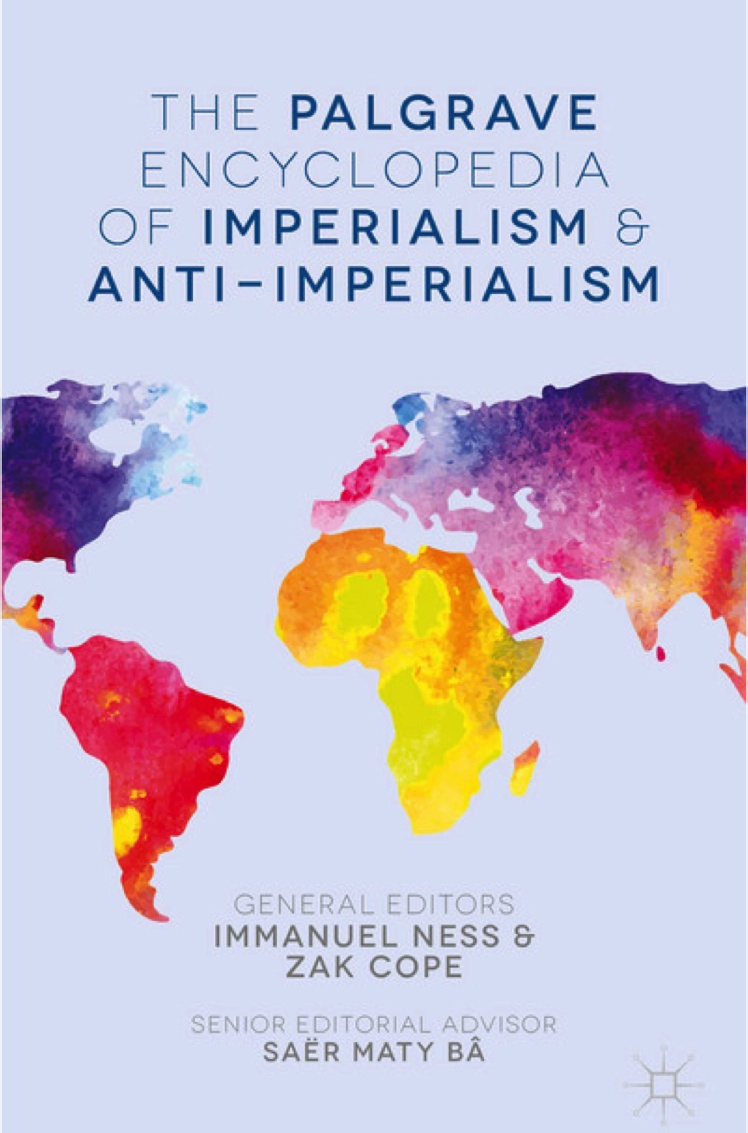
=========================================================================
Before we engage in this relatively long discussion of pan-Arabism, let us (Iranians) remind ourselves, that we too have our faults and are far from perfect. In fact, I have always found the attitudes of a number of Iranians against Arabs embarrassing and unfair. Nevertheless, the hostile anti-Iranian attitudes and actions of a minority of pan-Arabists are also shocking (you will read some of these in the commentary further below). As you read this article, please balance your feelings with how many of us Iranians are also embarrassingly chauvinist, with cultural expressions such as “uncouth Arab” or “Lizard eaters”. See for example:
- Eliminate demeaning ethnic jokes –جوک های قومیتی را ممنوع کنیم (Facebook)
- Danyal Lotfi: The Negative Impact of Racist Jokes
- Bahram Moshiri: Dangers of Iranian Aryanism
Few Iranians (or westerners) have heard of Pan-Arab nationalists such as Satia Al-Husri, Sami Shawkat, Michel Aflaq or Khairallah Tulfah. Their version of Arab nationalism is as anti-Western as it is anti-Persian. The philosophies of these men have done much to inspire generations of Arab leaders such as Gamal Abdel Nasser, who passionately advocated the changing of the Persian Gulf to “Arab Gulf”, or Saddam Hussein, who defined his Arabism by the extent of his brutality against Iranians (Kurds, Persians, etc.).
An erudite gentleman far ahead of his time: The late King Faisal (1906-1975) of Saudi Arabia. While few are aware, the king highly appreciated the cultural legacy of Persia in Arabian civilization and Islam (Picture Source: VOMU & Haseen Ahmad Ayazi). Few recall that the Iranian populace was deeply saddened when news arrived of the assassination of King Faisal on march 25, 1975, just days after the Iranian Nowruz new year (March 21).
The media often cherry-pick information to portray all Arabs in a negative light, to sway the international readership towards distorted and caricatured views of Arabs. The article below makes a clear distinction between Arabs versus the philosophy of pan-Arabism, just as “uber Aryanism” is not be equated with Iranians and Germans. Arab nationalism (or any nationalism for that matter) per se is not the issue either as long as it does not advocate racism, chauvinism and the creation of a nebulous “Other”.
 A Voice of reason, wisdom and tolerance by Arab-American scholar Professor Emeritus of Mass Communications from Southern Illinois University at Edwardsville, Jack G. Shaheen (Picture Source: Huffington Post). Professor Shaheen has often noted of the caricature images in the media with respect Arabs, Iranians and other “non-Western Others” in the media and movies. Readers are encouraged to read his books: Reel Bad Arabs: How Hollywood vilifies a People and The TV Arab.
A Voice of reason, wisdom and tolerance by Arab-American scholar Professor Emeritus of Mass Communications from Southern Illinois University at Edwardsville, Jack G. Shaheen (Picture Source: Huffington Post). Professor Shaheen has often noted of the caricature images in the media with respect Arabs, Iranians and other “non-Western Others” in the media and movies. Readers are encouraged to read his books: Reel Bad Arabs: How Hollywood vilifies a People and The TV Arab.
Undoubtedly, Iranians of all stripes are offended at the “Arab Gulf” scandal, not to mention pan-Arabist attempts at fomenting Arab racism against Iranians. A powerful distinction must be made between people who project ignorance and hatred, versus Arabs as a whole, who, in my opinion (and by personal experience), are kind, compassionate, intelligent, and resourceful. The writer can attest to several cases in his lifetime when Arabs have gone out of their way to assist him, often at great personal risk. The issue is neither (so-called) “race” or other divisive categories – the issue has always been a question of a minority of persons seeking to create division and discord. There are plenty of such persons across all (so-called) “races”.
To understand pan-Arabist thinkers, it is necessary to briefly sketch the history and origins of this movement and how this mindset remains a danger to international peace and stability. Al-Husri, along with other pan-Arab thinkers such as Michel Aflaq, helped forge the basis of the modern pan-Arabist identity of the 20th century. Unfortunately, as with other chauvinist philosophies such as Nazism, pan-Turkism, Persian chauvinism, Eurocentricism, pan-Arabist thinking leads inevitably to violence and confrontation, in this case against the Western and Iranian worlds.
The late Osama Bin Laden (1957-2011) was in fact the latest product of such pan-Arabism. The only difference between Bin Laden and previous pan-Arabists such as Saddam Hussein was that he overtly perverted the spiritualism of the Islamic religion, to further aggrandize his vision of pan-Arabist imperialism.
At the popular level, many Arabs continue to appreciate and respect the Iranians for their contributions to Arab and wider Islamic civilization. These same Arabs are continually distressed by the anti-Persian rhetoric of pan-Arabists. A perfect example of this are e-mails from Arab countries condemning the recent use of the term “Arab Gulf” by National Geographic. Note two examples cited below by the local Iranian Payvand newspaper in Vancouver (Vol.11, Issue 667, Friday, Dec.3, 2004):
“I am an Arab from UAE, my dad as well as my grandfather still call it Khalij Al-Farsi which means Persian Gulf…why do some people want us and Iranians to be enemies forever?“
“I am an Arab from Kuwait. I agree that the Persian Gulf should remain Persian (Parsi).“

Thomas Edward Lawrence (1888-1935) “Lawrence of Arabia”. Lawrence, as a member of British Intelligence, successfully cultivated Arab nationalist sentiments against the Ottoman Turks during World War One.
Pan-Arabism is simply defined as the desire to forge a single Arabian super state. The movement has its roots in the Arab revolt against Ottoman Turkish rule in World War One. British intelligence agents, personified in Thomas Edward Lawrence (1888-1935) “Lawrence of Arabia” or “Al-Lawrence” (see photo), excited the Arabs against the Turks, with promises of an Arab superstate stretching from the Persian Gulf to the Suez Canal (and beyond…). The Arab revolt was not anti-Persian, it was, for all intents and purposes, an independence movement against Ottoman Turkish rule.
The pan-Arab revolt was first proclaimed in the Hijaz. Pan-Arabism found its second home in Damascus, Syria. It was in Damascus that Turkish rule dramatically ended on October, 3, 1918, when victorious Arab warriors swept into this ancient city. The Arabs were to be sorely disappointed. Having used (or tricked?) the Arabs, the British and the French simply carved up the ex-Ottoman Empire’s Arab possessions into a series of artificial states such as Syria and Lebanon (under French supervision), with Palestine, Jordan, and Iraq falling under British jurisdiction. Faisal, a hero of the Arab revolt, was defeated by the French in Syria (Battle of Maysalun), but was recompensed by the British, who installed him as king in the newly formed state of Iraq. The birth of “modern” Arab nationalism, is to be found in the aftermath of these events, namely the Franco-British creation of separate Arabian states. The Arabs felt used and cheated by the west, a sense of anger that has pervaded their consciousness for a period close to 90 years.
By 1932, Iraq had been recognized as an independent state by the League of Nations; Syria, Palestine and Lebanon however, remained under French rule until the 1940s. Men such as Michel Aflaq (discussed later in this commentary), directly experienced the effects of French rule.
It was in Baghdad, Iraq where the first Arab nationalists, mainly of Palestinian and Syrian descent, formed the basis of their philosophy. Prominent figures are individuals such as Haj Amin Al-Husayni (the Mufti of Jerusalem), and Syrian nationalists such as Shukri al-Quwatli and Jamil Mardam. All had been exiled because of their desire to overthrow British and French rule. Rashid Ali, a native Iraqi, is well known by the Arabs for his pro-German coup in 1941 with hopes of driving out the British. In Syria, ideologues such as Michel Aflaq (a Christian) and Salah al-Din al-Bitar laid the basis of the present day Baath movements.

Haj Amin Al-Husayni (1895-1974) known as “The Mufti of Jerusalem”. Al-Husayni was among the first post World War One Arab nationalists vehemently opposed to colonial British and French rule of Arab lands. So far as is known, Al-Husayni was not anti-Iranian but unfortunately made the error of cooperating with the Nazis during World War Two.
What is of special consequence to Iranians is the type of individuals Faisal decided to install in the new Iraqi educational and political systems. Satia Al-Husri was bought to Iraq in 1921. He first served as advisor to the Ministry of Education; he then became Director General of Education and eventually became the Dean of the Law College. Husri quickly ushered in scores of fellow Palestinian and Syrian educators and these people helped shape the Iraqi education system. These individuals formed the nucleus and genesis of true pan-Arabism, and unfortunately, ushered in the basis of anti-Iranian thinking in mainstream Arab education and mass media.

Satia Al-Husri (1882–1968) one of the founders of the major pan-Arab nationalism. Of Syrian descent, Al-Husri was originally born Turkish and struggled to learn Arabic. It was Al-Husri who tragically introduced his racist brand of anti-Iranism into Arab nationalism. Al-Husri came to Iraq in 1922 and did much to integrate his personal brand of anti-Iranism into the new Iraqi state’s educational system and mainstream media.
Anti-Persian thinking can be seen in one of the father’s of pan-Arabism, the aforementioned Satia Al-Husri. Of special interest is one of Husri’s works entitled “Iranian Teachers who caused Us (Arabs) Big Problems“. His campaigns against schools suspected of being positive towards Persia are well documented. One dramatic example is found in the 1920s when the Iraqi Ministry of Education ordered Husri to appoint Muhammad Al-Jawahiri as a teacher in a Baghdad school. A short excerpt of Husri’s interview with the teacher is revealing (see Samir El-Khalil’s Republic of Fear, New York: Pantheon Books, 1989, p.153-154):
Husri: First, I want to know your nationality.
Jawahiri: I am an Iranian.
Husri: In that case we cannot appoint you.
Husri was overruled by the Iraqi ministry and Jawahiri was appointed. Jawahiri was in fact an Arab, however like many Arabs of his day and the present, Jawahiri saw no reason to follow Husri’s bigoted anti-Iranian racialism.
It is interesting that Husri, though claimed as a Syrian-Arab, was actually raised as a Turk in a Turkish household; he struggled to learn spoken and written Arabic. It would seem that Mr. Husri may have suffered from an identity or inferiority complex and like many such individuals in history (e.g. Adolf Hitler) found an outlet for his confused emotions by preaching hate against those of the “other” (i.e. Iranians).
Husri correctly deduced that it was through education, especially children, that the “new morality” of Arabism was to be transmitted. In this endeavor, he achieved a great success. In this mission he was helped by a certain British advisor to the Iraqi Ministry of education by the name of Lionel Smith. Smith seems to have admired Husri’s passionate zeal for education, but is on record for stating that many of Husri’s “views were wrong”. Husri’s attitudes against non-Arabs seem to have been adopted by his son Khaldun al-Husri, a nationalist Arab historian who has attempted to minimize the violent destruction of the Assyrian community in Northern Iraq in the 1920s. This is reflected in:
Husri, H. (1974). The Asyyrian affair. The International Journal of Middle East Studies, 5, 161-176, 344-360.
For an account of the Assyrian tragedy consult:
Stafford, R.S. (1935). The Tragedy of the Assyrians. London: Allen & Unwin Ltd.
Satia Al-Husri spawned a whole generation of men who advocated violence. One example is Sami Shawkat who is famous for his 1933 speech “Sina’at al-Mawt” (manufacture of death) in which he rationalizes mass violence and war as the way to achieve Arab aspirations. Tragically, this speech was widely distributed in Arab schools and in Iraq in particular. It is interesting that Shawkat teaches that:
“…force is the soil which sprouts the seeds of truth“.
Although not widely known, Shawkat was a main force in the organization of the Futuwwa Youth Organization – a movement modeled directly after the Nazi Hitler Youth Movement. The Futuwwa set the pace for future Arab chauvinist movements, such as the B’aath party of Iraq and today’s followers of Bin Laden. It is interesting to note that Shawkat’s ideas became somewhat too hot to handle, even for the pan-Arabists – Satia Al-Husri later disowned Sami Shawkat.
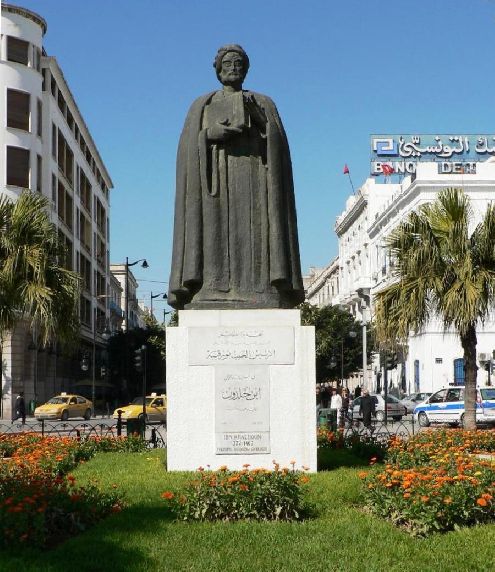 A statue of Arabo-Islamic historian, Ibn Khaldun (1332-1406) in Tunisia. Ibn Khaldun emphasized the crucial role of the Iranians in promoting learning, sciences, arts, architecture, and medicine in Islamic civilization. It was pan-Arabists such as Sami Shawkat who insisted that history books such as those by Ibn Khaldun be destroyed or re-written to remove all references of Iranian contributions to Islamic civilization. The former Baathist regime in Iraq promoted such policies and even worked alongside numerous lobbies to promote historical revisionism at the international level.
A statue of Arabo-Islamic historian, Ibn Khaldun (1332-1406) in Tunisia. Ibn Khaldun emphasized the crucial role of the Iranians in promoting learning, sciences, arts, architecture, and medicine in Islamic civilization. It was pan-Arabists such as Sami Shawkat who insisted that history books such as those by Ibn Khaldun be destroyed or re-written to remove all references of Iranian contributions to Islamic civilization. The former Baathist regime in Iraq promoted such policies and even worked alongside numerous lobbies to promote historical revisionism at the international level.
It is worth noting that Sami Shawkat’s brother, Naji, who by 1941 was a member of the Arab committee in Iraq (which had absorbed the Futuwwa), gave Franz von Papen (a high ranking German official of Nazi Germany in 1941) a letter which actually congratulated Hitler for the brutality that he inflicted upon the Jews.
Of far greater significance is the following quote that vividly describes Sami Shawkat’s thinking (see again Samir El-Khalil’s Republic of Fear, New York: Pantheon Books, 1989, p.177):
“History books that discredit the Arabs should be burned, not excepting the greatest work on the philosophy of history by Ibn Khaldun“.
But why Ibn-Khaldun? As a historian, Khaldun (1332-1406 AD) is ranked among the best in history, on par with the earlier Greco-Roman historians such as Plutarch or Xenophon; truly one of the most best scholars produced by the Arabs. To understand why pan-Arabists feel uncomfortable with Ibn Khaldun, one has to read a direct quote from his work, The Muqaddimah Translated by F. Rosenthal (III, pp. 311-15, 271-4 [Arabic]; R.N. Frye (p.91):
“…It is a remarkable fact that, with few exceptions, most Muslim scholars…in the intellectual sciences have been non-Arabs…thus the founders of grammar were Sibawaih and after him, al-Farisi and Az-Zajjaj. All of them were of Persian descent…they invented rules of (Arabic) grammar…great jurists were Persians… only the Persians engaged in the task of preserving knowledge and writing systematic scholarly works. Thus the truth of the statement of the prophet becomes apparent, ‘If learning were suspended in the highest parts of heaven the Persians would attain it”…The intellectual sciences were also the preserve of the Persians, left alone by the Arabs, who did not cultivate them…as was the case with all crafts…This situation continued in the cities as long as the Persians and Persian countries, Iraq, Khorasan and Transoxiana (modern Central Asia), retained their sedentary culture.”
You now see why Mr. Shawkat saw the need to destroy the history of Ibn Khaldun. Pan-Arabists from Gamal Abdel Nasser to today’s Bin laden have chosen to pretend that that the Persian intellectual legacy does not exist. It is not an exaggeration to state that Arab nationalists have re-written much of Arab history, especially as it pertains to Persian contributions to Islamic and Arabian civilization. The following observation by Sir Richard Nelson Frye encapsulates the crisis in Arab attitudes towards the Iranians (See R.N. Frye, The Golden Age of Persia, London: Butler & Tanner Ltd., 1989, p.236):
“Arabs no longer understand the role of Iran and the Persian language in the formation of Islamic culture. Perhaps they wish to forget the past, but in so doing they remove the bases of their own spiritual, moral and cultural being…without the heritage of the past and a healthy respect for it…there is little chance for stability and proper growth“
It may be argued that one source of the political, economic and technological stagnation so evident in the Arab world at present may stem from what has been taught (and continues to be taught) to Arabs at primary, secondary and post-secondary education.
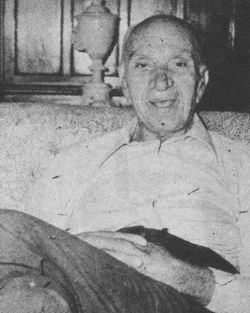 Sami Shawkat in his later years. A doctor by profession, Shawkat was also a nationalist leader with ties to the Nazi party of Germany before and during World War Two. Shawkat’s writings did much to lay the ideological foundations of pan-Arabism and the subsequent genocidal policies of Saddam Hussein. Shawkat extolled violence, advocated the ejection of Jews from Iraq and the burning of history books contradicting pan-Arabist ideology.
Sami Shawkat in his later years. A doctor by profession, Shawkat was also a nationalist leader with ties to the Nazi party of Germany before and during World War Two. Shawkat’s writings did much to lay the ideological foundations of pan-Arabism and the subsequent genocidal policies of Saddam Hussein. Shawkat extolled violence, advocated the ejection of Jews from Iraq and the burning of history books contradicting pan-Arabist ideology.
It should come as no surprise that many Arabs (including high ranking statesmen and highly educated professors) now believe that the following Iranian scholars of the Islamic era to be all Arabs: Zakaria Razi “Rhazes” (860- 923 or 932, born in Rayy, near Tehran), Abu Ali Sina “Avecenna” (980 -1037, born in Afshana, near Bukhara, ancient Samanid Capital), Abu Rayhan Biruni (973 – 1043, born in Khiva, Ancient Khwarazm now modern Afghanistan), Omar Khayyam (1044-1123, born in Nishabur, Khorasan), Mohammad Khwarazmi (d. 844, born in Khiva, Ancient Khwarazm, now in Modern Afghanistan). Not a single one of these scientists hailed from an Arab-speaking region, all were born in what is now Iran or the former realms of Persian speaking world.
This has posed an awkward contradiction for pan-Arab nationalists. Their counter to these facts, are mainly based on two premises:
(a) Men such as Biruni are claimed as Arabs simply because they had the name “Al-” attached to their last names or had Arab/Muslim names such as “Omar”. This is tantamount to saying that all great people in history with Christian names such as Chris, Michael, or John have been Jews, simply because their names are Jewish. Following this logic, we then must accept Christopher Columbus (Spain), Michaelangelo (Italy), and Johanes Kepler (Denmark) as Jews. Persia accepted Islam after the 7th century AD, just as Europeans accepted Christianity in great numbers after the 3-4th centuries AD. Simply, put, nationality and religious confession are not the same thing. One does not “become” an Arab simply because one is Muslim, just as one does not “become” Jewish simply because one is Christian. Pan-Arabists have simply stretched the definition of Muslim to conveniently include those non-Arabs whom they view favorably as Arabs.
(b) All of these men (without exception) are simply argued to be the descendants of Arabs who settled in Iran after the Arab conquests. While true that Arab garrisons occupied Persia for approximately 222 years, how and when did these warriors from the tough deserts of Arabia become scholars so quickly? Persia’s history and traditions of learning rival those of Greece, India and China, and like them, predates Arab civilization for thousands of years. When the Arabs erupted from their desert homes in Arabia and overthrew the Byzantine-Roman and Sassanian Persian empires, they simply inherited the rich legacy of Rome and Persia. Simply occupying another person’s territory does not entitle one to their achievements – in that case Greek scholars such as Democritus (Abdera, Ionia 460 – 370 BC), and Pythagoras (Samos, Ionia 582 – 500 BC) are automatically Persian, simply because Achaemenid Persian garrisons ruled the Ionian Greeks (present Western Turkey) at the time. The best retort to the pan-Arabists is the aforementioned Ibn Khaldun himself, who has made clear, in no uncertain terms, of the contributions that have been made by the Persians.
Many Arab nations, such as Egypt, simply avoid mentioning where the Iranian scholars were born and where they ultimately died. Many Arabs would be surprised to learn that the grave of Ibn Sina (Avicenna) is located in Hamadan, Iran.
To understand the awkwardness (and indeed irrationality) of pan-Arabism (or any form of racialism), one is compelled to also briefly learn about the true founders of the B’aath party; Michel Aflaq and Salah al-Din al-Bitar. Both were born in Damascus; Aflaq was a Greek Orthodox Christian and Bitar a Sunni Muslim. They both experienced the humiliating treatment of their country, Syria, at the hands of the French, especially during the 1925-1926 uprising. The two met as students in the University of Paris in 1929. It is unclear if they actually joined the Arab communist students in Paris at the time, but what is clear is that they formed their party on the basis of pan-Arabism, like the movements that had taken place in neighboring Iraq in the 1920s. Another influential and French (Sorbonne) educated Syrian, was Zaki al-Arsuzi. Al-Arsuzi was especially outspoken in his racism against the local Turks of Syria and especially venomous in his hatred against the Jews. To summarize, the followers of Arsuzi joined up with the Aflaq-Bitar team. Arsuzi himself intensely disliked Aflaq, which explains why he himself never joined in.
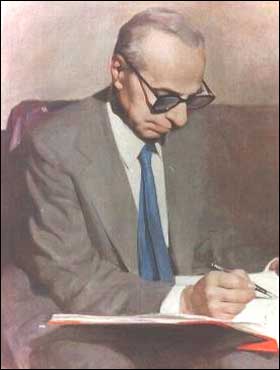 Michel Aflaq re-defined Islamic civilization in racialist terms, which led to the denial of the role of non-Arabs in that civilization.
Michel Aflaq re-defined Islamic civilization in racialist terms, which led to the denial of the role of non-Arabs in that civilization.
As a non-Muslim, Aflaq’s interest was not in the cultivation of a pan-Islamic identity, but in the promotion of pure pan-Arabism in the spirit of what he called “al-ruh al-Arabiyya” (the Arabian spirit). Faith and love for one’s race is the cornerstone of pan-Arabism, as it is with any kind of racial chauvinism. That same “Arab spirit” is what Aflaq relates to “the great deeds (of the Arabs) in the past, and can continue to do so in the present”. It is interesting that Aflaq also rejected those Arabs influenced or sympathetic to Western culture; exactly as Bin Laden does today.
Michel Aflaq defined Islam only as “a revolutionary Arab movement whose meaning was the renewal of Arabism” (see Khalil, p.198). It would seem that Aflaq, Bin Laden, Saddam Hussein, or the Husri and Shawkat clans have chosen to forget one crucial point: Islam (like all great religions), since its inception, went beyond the moronic and barbaric concept of race worship – Islam, like all of the world’s great religions (Zoroastrianism, Christianity, Hinduism, etc) rejects racial self-love in favor of the acceptance of others irrespective of race, ethnicity or color – all of mankind are seen as members of one another (to quote the Persian mystic Jalal-e-Din Rumi). As for Islamic civilization, one can again quote Samir al-Khalil (Republic of Fear, p.199-200):
“Arab ethnic hegemony was terminated under the Abbasids, Arabic culture very quickly metamorphosed into a wider Islamic civilization with the peoples of the fertile Crescent – Persians, Turks, Berbers, and Spaniards as well as Jews and Christians…”
Pan-Arabists such as Bin Laden, have perverted religion to further their own truly nefarious pursuits – one can look to many current white supremacists or religious fundamentalists to see the parallels. Unfortunately, numbers (though by no means the majority) of Arabian politicians continue to perpetuate very racist views in the Arab media, as seen in the video below of Iraqi politician, Adnan Al-Dulaimi.
Iraqi Sunni Politician Adnan Al-Dulaimi made the following statements on Saudi Arabia’s Safa TV (aired January 17, 2012): “When facing the Persian Personality you have no choice but to use force, they understand nothing but force…whenever they are in power, they want you to worship them, but when they are ruled by others who are stronger, they lick their boots…they become submissive to the point of masochism…Persian personality is characterized by insolence…” . It is notable that Mr. Al-Dulaimi rose to prominence after the fall of Saddam Hussein’s regime following the US-led invasion in 2003.
Aflaq went further than Satia Al-Husri in that he clearly outlined the “enemy of the (Arab) nation”. This broad encompassing term has entered many Arab educational and popular circles, resulting in a whole generation of individuals believing Iranians to be the “enemy of the Arabs” (Aflaq’s article “Us and Our Enemies” is often cited as providing insight into this type of thinking). Fortunately, many Arabs have bravely and courageously rejected this thinking; nevertheless, the impulse of anti-Iranianism has taken root in Arab education and mass media (e.g. the Al-Jazeera TV network).
It was in Saddam Hussein’s Iraq where Arab racism attained its most vulgar form, truly on par with the neo-Nazi philosophies of today’s white supremacists. A prime example is the 10-age document written in 1940 by Saddam’s maternal uncle, Khairallah Tulfah, entitled “Three Whom God Should Not have Created: Persians, Jews and Flies” (Arabic: ثلاثة كان على الله ان لا يخلقهم: الفرس، اليهود والذباب)
Tulfah’s writings became immensely popular during the 1980s. were widely distributed in Iraq during Saddam Hussein’s rule.
The Baathist regime of Iraq commissioned the Dar al-Hurriyya (Abode of Liberty) publishing house to re-print Tulfah’s document in 1981. To ensure that its program of racist indoctrination was disseminated as efficiently as possible, Saddam Hussein had the Iraqi Ministry of Education publish Tulfah’s document as part of a textbook for Iraqi schoolchildren.
Tulfah’s writings highlight the following:
- Persians are described as “animals God created in the shape of humans” (see Al-Khalil, S. (1989). Republic of Fear. University of California press. page 17)
- Jews are portrayed as a “mixture of dirt and the leftovers of diverse people“
- flies, the least bothersome of Tulfah’s nefarious three, are shown as unfortunate and misunderstood creatures “whom we do not understand God’s purpose in creating” (see Coughlin, C. (2005). Saddam: His Rise and Fall. Ecco Publishing. page 19).
It is also notable that Saddam Hussein had the Tulfah’s book title engraved onto a plaque which he placed on his desk. (consult Paul Kengor’s article “The rise and fall of a murderous dictator“, published in The Washington Times, January 7, 2007).
Even more incredible is the following description by Said Aburish (in Saddam Hussein: The Politics of revenge, London: Bloomsbury, 2000, p.123):
“…the (Saddam) government offered ‘pure Iraqis’ married to anyone with Iranian blood 2500$ reward for anyone divorcing them“
This quote is a chilling reminder of what happened in Nazi Germany in the 1930s (e.g. Nuremburg Rally) and the ensuing Nazi ‘racial purity’ laws against the Jews. Perhaps the best description of this tragedy is provided by Con Coughlin in his book Saddam: His Rise and Fall (Ecco Publishing, 2005) on page 19:
“This weak Iraqi attempt at imitating Mein Kampf nevertheless had a bearing on Saddam’s future policy making. As president of Iraq, Saddam’s foreign policy was determined by his hatred of the Persians, or Iranians as they are better known, and the Israelis.”
Saddam in fact expelled thousands of people of Persian origin from Iraq in the 1970s, many of whom live in Iran today. Perhaps most telling is Saddam Hussein’s speech in the aftermath of one of many massive deportations forced upon Iraqi nationals of Iranian origins:
“They were uprooted from the Iraqi soil, so that they won’t dishonor the Iraqi soil, the Iraqi air, and won’t dishonor the Iraqi blood when their blood mixes with the Iraqi blood through marriage. Thus, the revolution uprooted them from the roots to end them… So that the pure Iraqi nationalist, the honorable, remain with his forehead high forever…” (Saddam’s made this speech to a group of Iraqi Popular Army soldiers being sent to support the invasion of Iran – Al-thawra on February, 16, 1981).
This process had in fact begun from the early 1970s, where citizens would be forced out of their homes and marched into Iran (For more on this topic see: القسوة لدى صدام حسين-The case of Iraqis of Iranian origin).
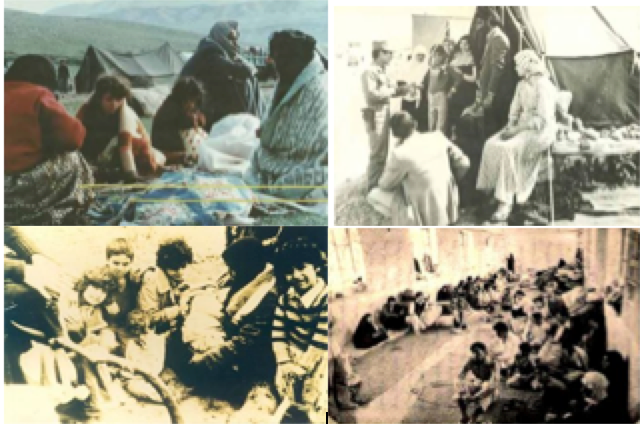 Pan-Arabism and Ethnic cleansing: Faili Kurds deported to Iran by the Baathist regime. The bottom right picture is a rare photo of Faili Kurds in an Iraqi detention center about to be deported to Iran in the mid-1970s. The other pictures are of Faili Kurds deported to Iran during the 1980s. The soldier in the above-left photo is of the Iranian army assigned as part of a team to orient (now ex-) Kurdish-Iraqi citizens to Iran (Photo sources: Gilgamesh.org and eKurd.net). As Iranian peoples, Kurds and Persians simply did not fit into the Baath party’s version of pan-Arabism. Saddam’s “final solution” was forced deportations, but as the war progressed and Saddam Hussein realized that the Western world “looked the other way” to his use of chemical weapons, he unleashed the horror of such weapons upon Iraq’s Kurdish population and also upon Iranian civilians and combatants alike. The majority of the Western press, politicians, and human rights organizations remained (and continue to remain) silent.
Pan-Arabism and Ethnic cleansing: Faili Kurds deported to Iran by the Baathist regime. The bottom right picture is a rare photo of Faili Kurds in an Iraqi detention center about to be deported to Iran in the mid-1970s. The other pictures are of Faili Kurds deported to Iran during the 1980s. The soldier in the above-left photo is of the Iranian army assigned as part of a team to orient (now ex-) Kurdish-Iraqi citizens to Iran (Photo sources: Gilgamesh.org and eKurd.net). As Iranian peoples, Kurds and Persians simply did not fit into the Baath party’s version of pan-Arabism. Saddam’s “final solution” was forced deportations, but as the war progressed and Saddam Hussein realized that the Western world “looked the other way” to his use of chemical weapons, he unleashed the horror of such weapons upon Iraq’s Kurdish population and also upon Iranian civilians and combatants alike. The majority of the Western press, politicians, and human rights organizations remained (and continue to remain) silent.
The horrific nature of Nazi-style these actions raise questions, especially with respect to Western media outlets, political venues and Human Rights organizations. Hardly any of these raised any objections against pan-Arabist racist policies against Iranian-speaking peoples (Kurds, Persians, etc.). In fact, as will be seen further below, much of West not only “looked the other way” but even supported Saddam Hussein’s pan-Arabist policies by supplying his regime with chemical weapons.
Although not generally known, up to a third of Baghdad’s population may have been Persian-speaking by the early twentieth century. Decades of sustained anti-Iranian propaganda certainly has had its effect in destroying Iraq’s vibrant Persian community. The Kurds, an Iranian people like the Persians, have certainly felt the violent brunt of pan-Arabism. The tragedies of Saddam’s gassing policies (i.e. Halabja) and the forceful expulsion of Kurds in favor of Arab settlers in Iraqi Kurdistan is so well known and documented that we need not pontificate further on this issue.
Even as I quoted Aburish’s description of Saddam’s ‘divorce reward’ policy, I was personally amazed. The Arabs would be shocked if they learned what ‘Iraq’ actually means. ‘Iraq’ is derived from Middle Persian or dialectical Pahlavi; it means ‘the lowlands’, like the Germanic term “Niederland” for modern day Holland. There is a region in Iran today which shares the same Pahlavi root as ‘Iraq’ – modern day Arak. The term ‘Baghdad’ is also of Iranian origin – “Boghu” (God) + “dad” (provided by, given by, bestowed by) – “Baghdad” is the rough Iranian equivalent of the term “Godiva“. The remains of the capital of the Sassanian Empire, Ctesiphon, stand only 40 kilometers from modern Baghdad.

Remains of the Archway of Khosrow (of the ancient Sassanian capital of Ctesiphon– see also Sassanian Architecture and Castles-کاخهای ساسانیان– and Ctesiphon-تيسفون–), located just forty kilometers from Baghdad in Iraq. The term “Baghdad” is old Persian for “Bestowed by God” or “Godiva”.
Iranians themselves may be shocked to learn that the term “Tehran” may not be of Aryan origin – this may have been an Assyrian settlement (before the Aryans came to dominate the Iranian plateau); the Assyrian term “Taharan” is roughly translated as “The place to which I shall return“. Of all Arab countries, Iraq has the strongest Persian legacy, as highlighted by this reference by Fred Halliday (Arabs and Persians – from Cahiers d’etudes sur la Mediterranee Orientale et le monde Turco-Iranien, no.22, July-December, 1996):
“…Iraq, open for centuries to Iranian influence, not least in the period of the Persian influenced Abbassid Empire, the very culture of the Arab speakers is suffused with Iranian influence. One only has to listen to spoken Iraqi, or look at the turquoise domes of the mosques of Iraqi cities, to see how strong the Iranian influence is…while Kurds who, by language and culture, fall very much within the Iranian cultural sphere“.
Negative portrayals of Iranians continue to appear today in Arab media and education: such as the caricature portrayal of Iranians by the Al-Jazeera Television network that is truly lamentable.More recently, an Arab television network televised a program that can be characterized as highly racist, as seen below.
Correct answer is “Al-Irani” [ال ايراني] to the question “Unclean and vile people living in the land of the pure” [شعب نجس وحقير يعيش في ارض طاهرة]. This was an Iraqi TV program which aired sometime in October 2012. Two questions may be posed: (1) who are the screenwriters of such programs? and (2) What purpose does it serve to promote racism on Television?
Arabs have complained (with justification) that they are portrayed negatively in western press, media and education, yet so many in the Arab world are unaware of the Pan-Arabist legacy of racism within their own ranks.
Incredible as it may seem, Pan-Arabism’s anti-Persian attitude has found unexpected allies in the western world: a handful of western academics and politicians propelled by political, economic and even romantic interests.
It was Richard Farmer in his book “A History of Arabian Music to the XIIIth Century” (London: Luzac Oriental, first published in 1929, reprinted in 1967, 1994, and 1996), who began to instill doubt on the Iranian nationality of the men of sciences cited above (e.g. Razi). The outright attack on Iran and its contributions to the Arabs is exemplified by Montgomery Watt (The majesty that was Islam: the Islamic world, 661-1100, New York, Praeger, 1974) who bluntly downplays Persian contributions as outright irrelevant. Watt’s denial and/or downplaying of any Persian heritage in Arab and wider Islamic civilization would have made Shawkat himself proud indeed.
The term “Arab Gulf” neatly encapsulates the history of western (mainly British) economic interests. It was Sir Charles Belgrave who first invented the term “Arab Gulf” and attempted to change the name of the Persian Gulf. Belgrave was the British advisor to the Arab leadership of Bahrain in the 1930s. Belgrave proposed his “Arabian Gulf” invention to the British Foreign and Colonial offices in London, where the project was quietly dropped. Belgrave however had succeeded in a way; he had set the stage for future Iranian and Arab friction.
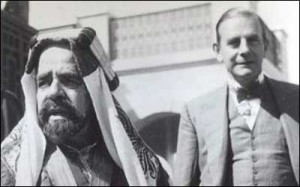 Shaikh Salman Bin Hamad Al-Khalifa (at left) and Sir Charles Belgrave (right) who was England’s Government Advisor to Bahrain. It was Belgrave who first pioneered the concept of changing the name of the Persian Gulf. The motives for such revisionist schemes are not clear, but it is possible that Belgrave was calculating that such actions would create frictions between the Iranians and the Arabs.
Shaikh Salman Bin Hamad Al-Khalifa (at left) and Sir Charles Belgrave (right) who was England’s Government Advisor to Bahrain. It was Belgrave who first pioneered the concept of changing the name of the Persian Gulf. The motives for such revisionist schemes are not clear, but it is possible that Belgrave was calculating that such actions would create frictions between the Iranians and the Arabs.
The British themselves soon began to see the benefits of propagating the “Arab Gulf” project, especially after Dr. Mohammad Mossadegh took control of Iran’s oil industry from the British in the 1951. Furious at this perceived outrage, Roderic Owen, a British secret agent linked to British Petroleum (originally Anglo-Iranian Oil Company) saw the potential of using “Arab Gulf” as a weapon against Iran. Owen eventually published and promoted a book called “The Golden Bubble of the Arabian Gulf: A Documentary” (London: Collins, 1957). The British were not going to be ejected from the Persian Gulf without a fight – and what better way than the famous “Parthian shot” of attacking the heritage, history and civilizational legacy of Persia herself. For an excellent synopis of the attack on the name of the Persian Gulf, please refer to Mahan Abedin’s article.
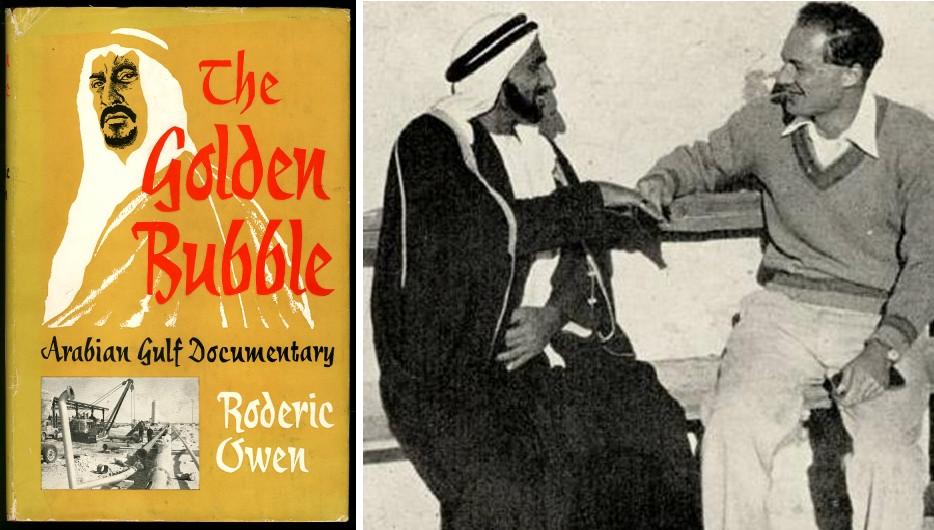 Photograph at Right: Roderick Fenwich Owen in khaki trousers conversing with the Sheikh of Ras al-Kheima (circa late 1950s) – Photograph at left: Owen’s 1957 book which finally popularized the “Arab Gulf” concept. Owen’s application of “Arab Gulf” to the historical Persian Gulf was not protested by the British and Western academics/historians. There are in fact Western professors active within Iranian Studies programs who have written books in support of the Arab Gulf thesis (see Daniel Potts further below). Similarly, when Spiegel magazine and the Daily Telegraph attacked the legacy of Cyrus the Great and even insulted the people of Iran, no professors of Achaemenid studies raised any protests (see for example Iranian.com).
Photograph at Right: Roderick Fenwich Owen in khaki trousers conversing with the Sheikh of Ras al-Kheima (circa late 1950s) – Photograph at left: Owen’s 1957 book which finally popularized the “Arab Gulf” concept. Owen’s application of “Arab Gulf” to the historical Persian Gulf was not protested by the British and Western academics/historians. There are in fact Western professors active within Iranian Studies programs who have written books in support of the Arab Gulf thesis (see Daniel Potts further below). Similarly, when Spiegel magazine and the Daily Telegraph attacked the legacy of Cyrus the Great and even insulted the people of Iran, no professors of Achaemenid studies raised any protests (see for example Iranian.com).
Owen’s success as a British secret agent is outmatched only by Ian Fleming’s James Bond 007. His genius set the stage for the full ignition of the Arabs against Iran, allowing the British to avoid direct confrontation. Significantly, Owen had provided fresh ammunition to a new generation of post Al-Husri Arab chauvinists, now coincidentally coming to the fore in the 1950s.
Western Arabism is basically a combination of political-economic interests (briefly addressed below) and raw admiration of the Arab Bedouin. The latter (admiration of the Arab Bedouin) deserves some mention. As noted by Barrie Pitt in History of World War One (edited by A.J.P. Taylor, London: Octopus Books, 1974, p.136):
“Englishmen…appreciated the Arabs’ virtues…have overlooked their weaknesses…when subjected to the persuasive charm of the Bedouin…”.
This “persuasive charm” (along with petro-dollars) has been able to overpower a number of western (mainly English-speaking) academics, politicians and businessmen. To obtain an understanding into the mindsets of such men as Sir Charles Belgrave, Roderic Owen, or Montgomery Watt consult:
McLoughlin, L. (2002). In a Sea of Knowledge: The British Arabists in the Twentieth Century. Reading, UK : Ithaca Press.
Kaplan, R. D. (1995). The Arabists: The Romance of an American Elite. New York: The Free Press, A Division of Simon & Schuster Inc.
Many well intentioned but naïve westerners often selectively and exclusively praise the Arabs for their contributions to medicine, the sciences and mathematics. The Arabs certainly are on par with all the great peoples of history, and their contributions to civilization certainly cannot be dismissed. Nevertheless, the extent of their contributions are being highly exaggerated by certain Arab chauvinists and their western Arabist sympathizers with political, economic and romantic agendas.
From the western viewpoint, this error can be traced to the false fallacy of defining all Muslims as Arabs, a problem that began during the Arab occupation in Spain. The terms “Arab science” or “Arab soap” gained currency among the Western Europeans of the period. Europeans then (and today) identified “Arab” and “Muslim” as synonymous. “Muslim” is no more a “race” than is “Christian”. No one speaks of “Christians” as an “ethnic group”. This false and simplistic logic in the western world has resulted in the identification of Iranians as Arabs by current western education, popular media and press.
This logic can be applied to Catholic Christians, with silly results: as Filipinos are Catholic then they must be Italians! Many Westerners have fallen victim to this dangerously false line of logic as it pertains to Iranians, with tragic academic results.
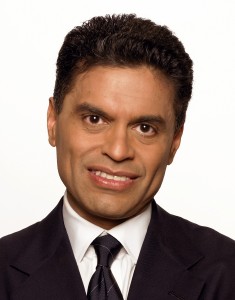 Fareed Zakaria of CNN who produced a map of the “Arab World” which incorrectly defined Iran as an Arab nation (see Newsweek, Dec. 24, 2001).
Fareed Zakaria of CNN who produced a map of the “Arab World” which incorrectly defined Iran as an Arab nation (see Newsweek, Dec. 24, 2001).
An example of this misinformed narrative is evidenced in the Newsweek magazine articles by Fareed Zakaria (see photo) “Why Do They Hate Us?” (October 15, 2001) and “How to save the Arab world” (Dec. 24, 2001). Zakaria inaccurately (or perhaps deliberately) portrays Iranians as Arabs by depicting Iran as a member of the Arab world (depicted on map of p.37 of October 15, 2001 Newsweek article). He also states that “Arabs…invented algebra” (October 15, 2001, p.29). To my knowledge, Newsweek has never replied to, apologized or retracted from Mr. Zakaria’s statements.
In another more recent program entitled “Why do They hate US?” (first aired Monday evening, May 23rd, on CNN) Mr. Zakaria suggested that the origins of Muslim anti-Western fundamentalism are traced to the experiences of an Egyptian student in the US who was appalled at the mixing of men and women in a 1950s dance hall. As noted in an excellent critique of the Zakaria program by Kambiz Zarrabi (“Why Do They Hate Us?”: Ask the Catfish!):
“He [Zakaria] goes back to the very first, as he maintains, seeds of the hatred of Western values planted in the Islamic world by Seyyed Qutb, a young Egyptian student who was horrified by what he saw at a church social he had attended in a Colorado town in 1949. According to Fareed, this man, who had opposed Gamal Abdel-Nasser’s westernization programs in Egypt, and was jailed and executed as a result, founded the anti-West ideology that led to the rise of people like Bin Laden and his mentor, Aimen Al-Zawahiri, as well as the Wahhabi style Islamic extremism in Saudi Arabia, etc.”
Zakaria’s program simply omitted mention of the role of British intelligence in helping to form the Muslim Brotherhood (today pan-Islamists, Wahhabists, pan-Arabists, etc.). As noted by Dreyfuss and LeMarc:
“The son of Shah Wallullah, Shah Abdel-Aziz, gathered around him a network of disciples who visited India in 1809. Radiating from Indian centers where the British Colonial Office ruled, Eastern mysticism engendered a revival of xenophobic, Islamic purity that considered all outside influences as suspect and evil. Some of the Islamic orders demanded that all Muslims safeguard themselves from the penetration of Persian traditions and Indian habits” (Dreyfuss & LeMarc, 1980, p.119; Dreyfuss, R. & LeMarc, T. (1980). Hostage. New York: New Benjamin Franklin House Publishing Company).
Imperial England was keen to seek and promote those “Muslims” who disliked the legacy of India and Iran in Islam. This coincided with British imperial objectives at the time. This was because this type of extremist ideology helped prevent India’s Muslims and Hindus from uniting against British rule in India.
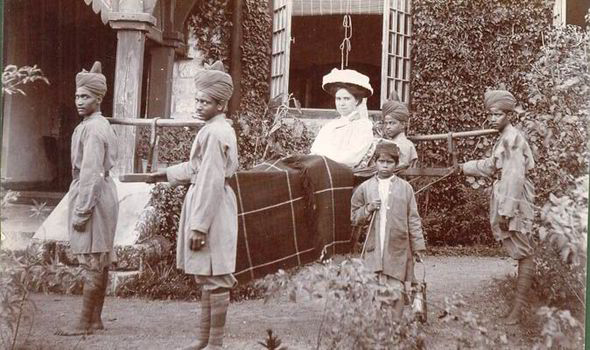
British lady in India being transported in a sedan by her Indian servants in 1895 (Source: The Express-Last days of the Raj: New drama Indian Summers about final years of British colonial rule). The British Colonial Office promoted anti-Indian/anti-Persian Muslim fanaticism to undermine cultural unity between India’s Hindus, Sikhs and Muslims. Put simply, the British Empire viewed Muslim fundamentalism as a useful tool to maintain their rule in their Indian colony. Another useful tool in the British arsenal was to ban the Persian language as a common lingua Franca in India. This too undermined cultural unity between India’s diverse populations, as well as India’s ties with the Persianate civilizations.
The promotion of anti-Iranism also assisted the undermining of Iran’s cultural legacy in India. The British were especially sensitive about the popularity of the Persian language in India, especially as this not only helped unite India’s Muslims, Hindus, Sikhs, etc. but also served as a cultural bond between the Indian subcontinent, Iran, Afghanistan and Central Asia.
Islamic extremism served British imperial interests very well: in modern-day Pakistan for example, the legacy of the Persian language is shunned at the political, religious and even cultural levels. Much of this is due to the massive efforts of the Saudi Arabian establishment’s efforts in exporting Wahhabism. What is remarkable however, is that within Iran itself, pan-Muslim activists and their leftist ideological partners have also been hard at work in what can be termed as “Persephobia”.
By the early 20th century, the alliance between the British and the Muslim Brotherhood had become more open. In 1910 Ibn Saud told Shakespear of his desire to form an alliance with the British against the Ottomans (Allen, 2006, p.245). Ibn Saud stated to William Shakespear (British political agent in Arabia at the time) that:
“We Wahhabis hate the Turks only less than we hate the Persians for the infidel practices which they have imported into the true and pure faith revealed to us in the Koran” (Allen, 2006, p.245).
Many Western laypersons, media outlets (i.e. Farid Zakaria & CNN, etc.) and academics believe that the Ikhwan al-Muslemeen (Muslim Brotherhood) and its modern offshoots (i.e. Taliban, etc.) is an exclusively anti-Western organization. This is only part of the truth: this movement is equally anti-Indian and anti-Iranian as it is anti-Western.
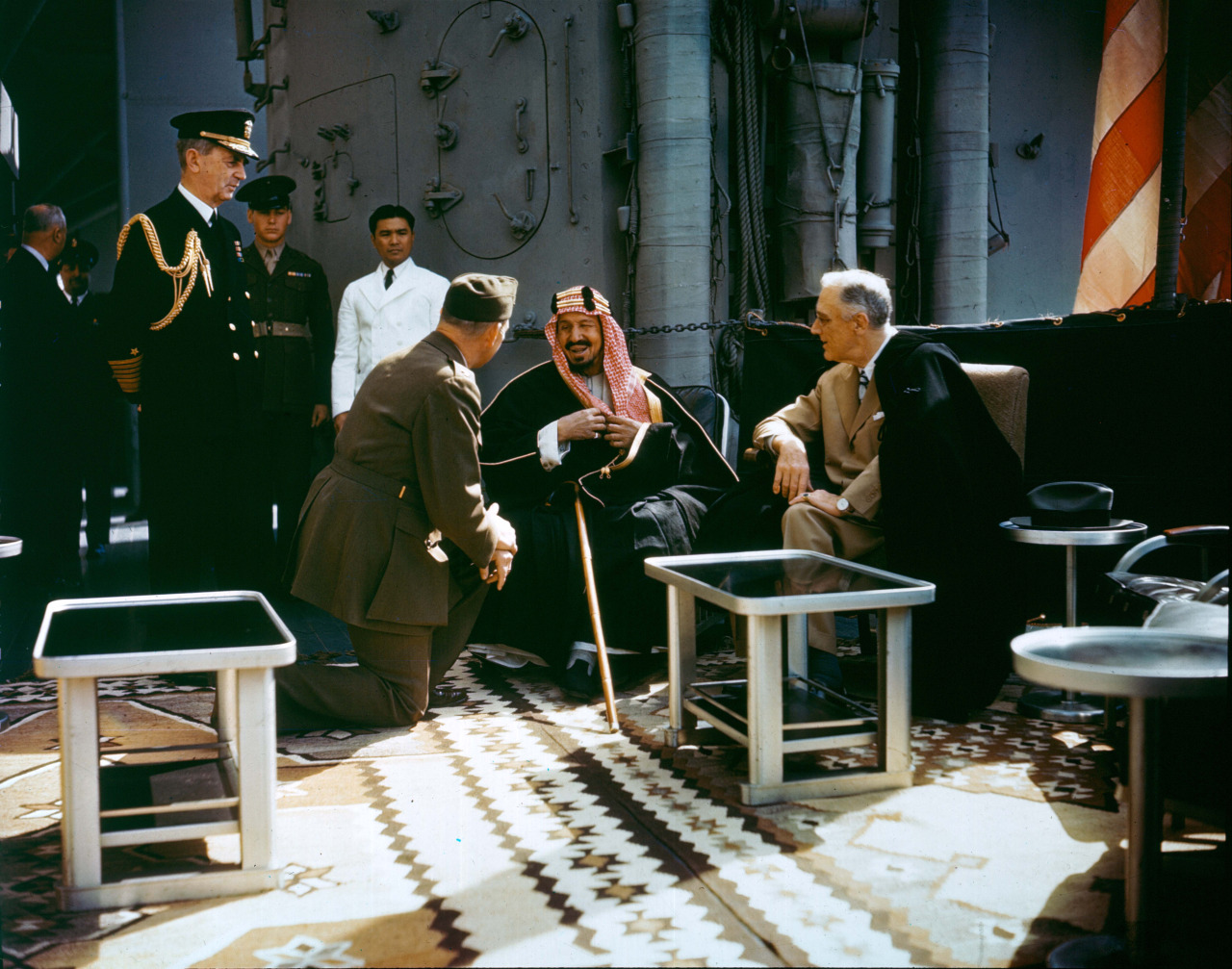
King Abdulaziz ibn Abdul Rahman Al Saud (reigned 1932-1953) meeting with US President Franklin D. Roosevelt (1882-1945) (at right) aboard the US warship, USS Quincy, after the Yalta Conference (Feb. 4-11, 1945) (Source: Public Domain). The interpreter is Colonel Bill Eddy with Fleet Admiral William D. Leahy located to the left. Ibn Saud is on record for his racist statement “…we hate the Persians…”. Western statesmen and business lobbyists to the present day continue to ignore these types of attitudes among non-European leaders in favor of commercial and geopolitical interests.
A cursory examination of the origins of the Ikhwan al-Muslemeen (Muslim Brotherhood) in the 19th century reveals the organization as having strong anti-Iranian and anti-Indian traditions at its ideological core. Allen has perhaps summarized the thinking of the Ikhwan:
“…Out of the ruins of the Caliphate a brilliant, inclusive Islamic civilization flowered under the Mongols, centered on Persia, rooted in Sufism, and predominantly Shia. But Ibn Taymiyya and others who followed the Hanbali code of jurisprudence the last, strictest and least popular of the four main schools law in the Sunni tradition… this civilization was anathema and an offense to God” (Allen, 2006, p.44; Allen, C. (2006). God’s Terrorists: The Wahhabi Cult and the Hidden Roots of Modern Jihad. London, England: Abacus.).
It is true that Islam is the predominant religion of Iran, but that does not make it an “Arab” country. By “Arabs“, Mr. Zakaria may be referring to general facets of “Islamic” culture; however this would include other non-Arab Muslims such as Che-Chens, Turks, Bosnians, Pakistanis, Filipino Huks, or the Sinkiang Turks of Northwest China. Islam is a multi-cultural society that includes many races and distinct cultures. The use of the term “Arab” is analogous to our previous example of Filipinos being “Italian” simply because they are Roman Catholic. With this failure at distinguishing religion from ethnicity, Mr. Zakaria has set the standard of academic mediocrity. It is a mystery as to (a) why he is so favored by the American media (he is regularly invited to television as an “expert”) (b) why he has received awards for his misleading and simplistic writings on the Near East.
One should not be surprised as to why over 80 percent of North Americans (and a growing number of Europeans) believe Iranians to be Arabs (see Jack Saheen’s “The TV Arab“, Bowling Green Press, 1982). The recent row over the use by National Geographic of the invented term “Arab Gulf” in parallel with the historical and legal “Persian Gulf” is simply another example of substandard (and politically motivated?) scholarship.
The “Arab Gulf” gospel was picked up quickly in Egypt by Eli Cohen, a Syrian Jew in league with the B’aath party. Cohen was later executed in Syria on charges of being an Israeli spy.
It was Gamal Abdel Nasser however, the enigmatic pan-Arab nationalist leader from Egypt, who truly popularized Belgrave-Owen’s “Arabian Gulf” to the Arab masses in the 1950s. His fiery rhetoric and emotional calls for Arab unity envisaging confrontation with Iran, found a largely receptive audience, thanks to a generation of Arabs exposed to the Al-Husri-Shawkat school of education. The tiny Sheikdoms of the Persian Gulf gleefully chimed in with Nasser, bankrolling the Belgrave-Owen project with vast sums of petrodollars. The aim was to not only change the name of the Persian Gulf, but to change world history as it applied to Persia. The “Arabization” of Persian contributions on the world stage was in full swing by the 1960s and 1970s.
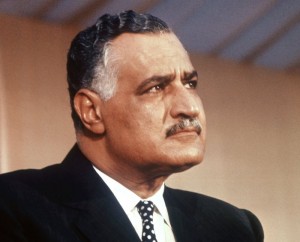
Gamal Abdul Basser (1918-1970). Known for his honesy and integrity of character, Nasser was a tragic victim of the ideology of pan-Arabism by his advocacy of changing the historical name of the Persian Gulf. Some have speculated that Nasser may have been partly motivated to do so due to his dislike of the late Shah of Iran.
Politics makes strange bedfellows indeed: British oil imperialism and pan-Arabism were united in their quest to diminish and ultimately marginalize Persia’s legacy and heritage in world history. This is exemplified by the BBC’s adoption of the term “The Gulf”, truly one of the pan-Arabists’ greatest successes. Other British media have followed suit, and thanks to the standard set by the BBC for its “impartiality”, other European and North American media outlets have followed suit.
Pan-Arabism and Nasser’s prestige greatly suffered however, after the Israeli armed forces crushed Arab military might in 6 days in 1967. The mantle of pan-Arabism was adopted by the B’aath regime of Iraq in 1968, which saw Saddam Hussein, rise to full power by 1979. The B’aath regime struck a very close alliance with Abu Dhabi in order to provide international legitimacy to Belgrave-Owen’s “Arabian Gulf”.
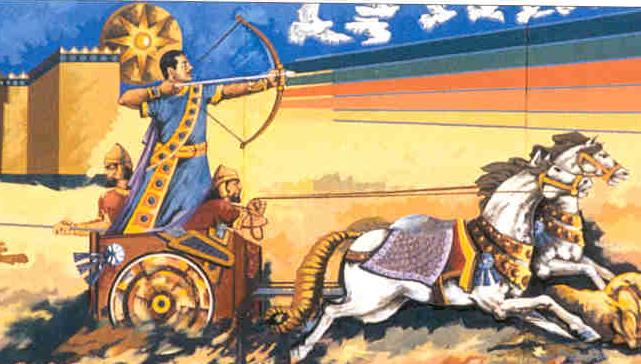 Propaganda poster portraying Saddam Hussein as Assyrian king Ashurbanipal. The Baathist propaganda machine worked hard to re-write history to promote its ideology. Schools and even universities often taught pupils that the Mesopotamian homeland has always been at war with the Iranians since ancient times. This of course is a gross distortion given the mutual anthropological, archaeological and cultural influences that the Iranian plateau and Mesopotamia have enjoyed for millennia.
Propaganda poster portraying Saddam Hussein as Assyrian king Ashurbanipal. The Baathist propaganda machine worked hard to re-write history to promote its ideology. Schools and even universities often taught pupils that the Mesopotamian homeland has always been at war with the Iranians since ancient times. This of course is a gross distortion given the mutual anthropological, archaeological and cultural influences that the Iranian plateau and Mesopotamia have enjoyed for millennia.
The Iraqi-Abu Dhabi axis proved successful. A series of fabricated academic conferences and dubious institutions (e.g. Centre for Arab Gulf Studies in Basra) were established to project pan-Arabism into western academic and political circles. With respect to the latter, the pan-Arabs have had a powerful and receptive lobby in the west. The aforementioned British Petroleum and other companies such as Aramco, Llyods Shipping and Shell simply could not resist the prospect of billions of petrodollars being pumped into their coffers. Acceptance of the Belgrave-Owen “Arab Gulf” in financial and political transactions is simply “good business”.
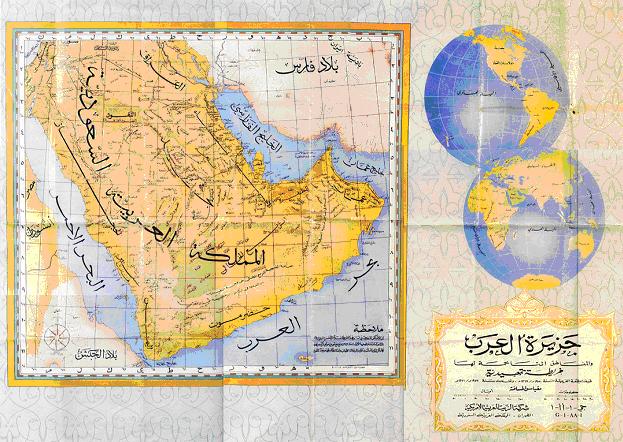
Saudi Arabian Map of 1952 displaying the correct name for the Persian Gulf.
The fact that western (mainly English) academics are vigorously supporting and promoting the Owen-Belgrave “Arab Gulf” project cannot be mere coincidence. In fact, a plethora of books, especially from the 1980s onwards, have greatly aided the cause of pan-Arab nationalists such as Bin laden. Note just three of such texts that have been published in England, Europe and North America since the publication of Owen’s book in 1957:
Pridham, B.R. (1985).The Arab Gulf and the West. Published in London: Croom Helm and Centre for Arab Gulf Studies, University of Exeter.
Potts, D.T. (1991). The Arabian Gulf in Antiquity: Volume I: From Prehistory to the Fall of the Achaemenid Empire. Oxford University Press.
Rice, M. (1994). The archaeology of the Arabian Gulf, c. 5000-323 BC. London ; New York : Routledge, 1994.
Olsen, P.R. (2002). Music in Bahrain: traditional music of the Arabian Gulf. Moesgaard: Jutland Archaeological Society : Moesgaard Museum ; Bahrain : Ministry of Information.
These titles are oxymoronic in academic, historical and legal terms. Ever since recorded history the Greeks have referred to the waterway as “Sinus Persicus”, followed by the Romans (Aquarios Persico). Historical archives, maps and historians, including Arabs, have recognized the waterway as such (see George F. Hourani, Arab Seafaring, New Jersey: Princeton University Press, p.85).
Refer also to the Iranian Studies Group at MIT for a recent compendium of maps that indicate the Persian Gulf as the name for that body of water.
Professor Daniel Potts of the University of Sydney. (top left) and his textbook “The Ar..bian Gulf in Antiquity” (top right) which is being used as a standard reference in Arabian universities such as the University of Sharjah (bottom image – click to Enlarge). In the above book, Potts argues that the Persian Gulf was known as Ar…b Gulf since pre-Islamic times. To his credit, Potts has seemingly retracted from this and now acknowledges that the Persian Gulf is the correct historical name. However his book continues to be distributed.
If Fareed Zakaria has set the standard of academic mediocrity, he at least has the excuse of not being competently educated. What is hard to comprehend is that why highly educated professors such as Daniel Potts Pridham, Rice or Olson have themselves been seduced into academic mediocrity? More seriously, are the distinguished professors aware of how much they have aided the cause of the likes of Sami Shawkat, Khairallah Tulfah or Mr. Bin Laden?
The only reference to “Arab Gulf” is found with respect to the Red Sea of antiquity (e.g see Herodotus’ “Histories”, p. Penguin Books). It is interesting that neither Belgrave nor Owen made the proposal to change the name of the Red Sea to its former name, Arab Gulf. This is because neither Belgrave nor Owen were interested in scholarship; their aims were political and economic. Despite Arab attempts (and their western political and academic protégés), the United Nations has twice recognized the legality of the term “Persian Gulf” (UNAD 311/March 5, 1971 and UNLA 45.8.2 (c) on August 10, 1984). It is significant that all Arab countries (including Iraq, Egypt and Abu Dhabi) have signed both of these documents.
The above mentioned UN resolutions, or historical references are simply ignored by Arab universities. Note the link below pertaining to the University of Sharjah’s College of Arts & Science course description for “History of the Arabian Gulf (course code: 0203102)” (click this link).
One can only guess at what is being taught in these classrooms. These are people who will represent future Arab leaders in business, education and politics.
The ultimate tragedy of Arab chauvinism is indeed expressed by the attack of Saddam Hussein against Iran in September, 22, 1980, 47 years after Sami Shawkat’s “Sina’at al-Mawt” (manufacture of death) speech.

King Khalid ibn Abd al Aziz Al Saud of Saudi Arabia (1975-1982) who called on the late Saddam Hussein to “crush the stupid Persians”.
On September 22, 1980, Pan-Arabism graduated from hate literature to outright violence: the Iraqis invaded Iran. Just as the Iraqi tanks were rolling into Iran, King Khalid of Saudi Arabia (1975-1982) (see photo) stated publicly to Saddam to “crush the stupid Persians“. It is sad that so much of the world at the time, threw its support for the Saddam regime and its genocidal policies.
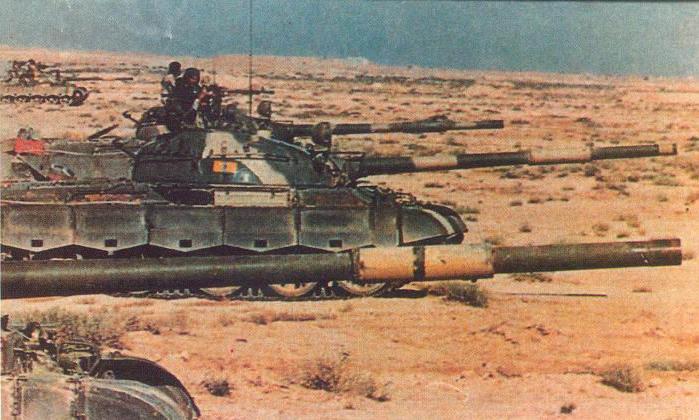 Pan-Arabism and Persophobia graduate from hate literature to violence: T-62 tanks of the Iraqi 6th Armored Division crossing the border into Iran on 1400hrs September 22, 1980. Saddam Hussein and the Baath party were convinced that as their tanks rolled into Khuzestan, they would be greeted as liberators by the Iranian Arabs. This may partly explain why the Iraqis may have miscalculated in the first few days of their invasion of Khuzestan province by not allowing more infantry to accompany their rapid-moving armor (see Iran at War: 1500-1988, 2001, pp.344-355). Instead of being hailed as liberators, Saddam Hussein’s forces were greeted with bitter opposition by the Iranian Arabs whose dogged resistance assisted the overall Iranian effort at slowing down the Iraqi advance (Photo Source: www.Acig.org).
Pan-Arabism and Persophobia graduate from hate literature to violence: T-62 tanks of the Iraqi 6th Armored Division crossing the border into Iran on 1400hrs September 22, 1980. Saddam Hussein and the Baath party were convinced that as their tanks rolled into Khuzestan, they would be greeted as liberators by the Iranian Arabs. This may partly explain why the Iraqis may have miscalculated in the first few days of their invasion of Khuzestan province by not allowing more infantry to accompany their rapid-moving armor (see Iran at War: 1500-1988, 2001, pp.344-355). Instead of being hailed as liberators, Saddam Hussein’s forces were greeted with bitter opposition by the Iranian Arabs whose dogged resistance assisted the overall Iranian effort at slowing down the Iraqi advance (Photo Source: www.Acig.org).
Note the following excerpt by Eric Margolis in the Toronto Sun (Sunday, January, 19, 2004):
Britain, the U.S., Kuwait and Saudi Arabia convinced Iraq to invade Iran, then covertly supplied Saddam with money, arms, intelligence, and advisers…Italy, Germany, France, South Africa, Belgium, Yugoslavia, Brazil, Chile and the USSR all aided Saddam’s war effort against Iran, which was even more a victim of naked aggression than was Kuwait in 1991″.

Saddam Hussein (1937-2006). Saddam’s hatred of Iranians endured right up to his last moments – he was shouting “down with the Persians” even as the noose was tightening around his neck during his execution on December 30, 2006 (see December 31, 2006 BBC Report “Saddam Hussein’s last moments “ and New York Times report, December 31, 2006).
The Saddam regime believed that they would win the war in less than 2 weeks. Instead of a lighting victory, the Iraqis and the Arab world became bogged down for eight years in a wasteful, useless and inconclusive war against Iran. This was a war with no winner, millions of lives were lost and billions of dollars worth of damage was inflicted upon the national infrastructures of Iran and Iraq. Arab volunteers streamed from the entire Arab world to fight against what Saddam Hussein called the “fire worshipping Magi of Persia” (in reference to Iran’s Zoroastrian past).
Saddam Hussein adn the Baath party spared no expense to incite racial hatred against the Iranians. The Baath party commissioned a high-budget motion picture entitled “Al-Qadissiya” with the help of Western producers to narrate the historical events of the 637 battle of Qaddissiya which resulted in a major victory by the invading Arabs against the the Sassanian Empire.
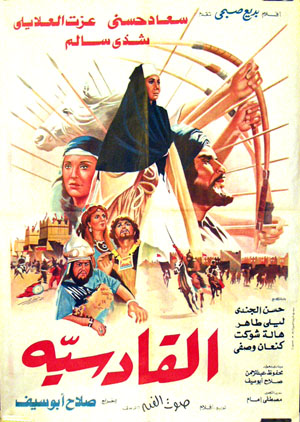 The Baathist commissioned movie “Al-Qaddissiya” produced in 1981. The movie is replete with historical errors and outright falsifications. While too numeorus to cite here, errors include the false notion that Zoroastrians were “fire-worshippers” when in fact the reverance for fire was simply part of a series of thousands-year long rituals venerating a single omni-potent god (Ahura-Mazda). Thanks in large part to pan-Arabist rhetoric, numbers of Arabs do beleive that the ancient Iranians were “fire-worshippers” that needed to be “rescued from ignorance” by the Arabs.
The Baathist commissioned movie “Al-Qaddissiya” produced in 1981. The movie is replete with historical errors and outright falsifications. While too numeorus to cite here, errors include the false notion that Zoroastrians were “fire-worshippers” when in fact the reverance for fire was simply part of a series of thousands-year long rituals venerating a single omni-potent god (Ahura-Mazda). Thanks in large part to pan-Arabist rhetoric, numbers of Arabs do beleive that the ancient Iranians were “fire-worshippers” that needed to be “rescued from ignorance” by the Arabs.
It was largely with this anti-Iranian (or even persophobic) mindset that propelled Arab volunteers – notably Sudanese, Egyptians, Morrocans, Syrians, Jordanians, Yemenis, Algerians, Lebanese and Palestenians to fight alongside Saddam Hussein’s forces invading Iran. Few are aware that among Saddam Hussein’s most ardent supporters of Saddam’s invasion was Yasser Arafat (see his embrace of Saddam in the early 1980s).
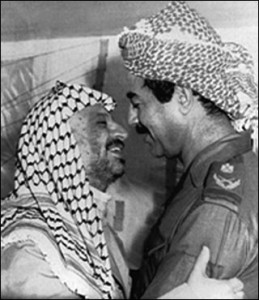 Saddam Hussein (right) and Yasser Arafat (left). Arafat had obtained 2 billion dollars of funds from Iran just a year before Saddam’s army invaded Iran. Many Palestinians fought as volunteers against Iran during the 1980-1988 war, even as revolutionary activists in Tehran were advocating the Palestine issue throughout the 1980s.
Saddam Hussein (right) and Yasser Arafat (left). Arafat had obtained 2 billion dollars of funds from Iran just a year before Saddam’s army invaded Iran. Many Palestinians fought as volunteers against Iran during the 1980-1988 war, even as revolutionary activists in Tehran were advocating the Palestine issue throughout the 1980s.
Pan Arabism on the march: Sudanese volunteers in Baghdad ready to fight against Iran. The Iraqi army had numerous Arab nationalities in its service including Sudanese, Jordanians, Palestinians, Egyptians, etc. There were reports of other “volunteers” from non-Arab countries such as the Ivory Coast and Pakistan fighting on Behalf of Saddam Hussein.
Note in the photograph below, the diverse range of Arab nationalities and races in Iraqi service, seen here captured by the Iranian army in February, 1984 (photo below):
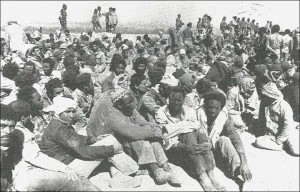
[Click photo to Enlarge] “Iraqi” POWs captured by Iranian troops (right). Note the diverse nationalities that have been pressed into Saddam Hussein’s army.
Never in modern Arab history have the Arabs shown such long-term zeal, persistence, enthusiasm and unity against a common foe. It is fortunate for the western world and Israel that the Arabs have never been as persistently unified against them as they have been against Iran.
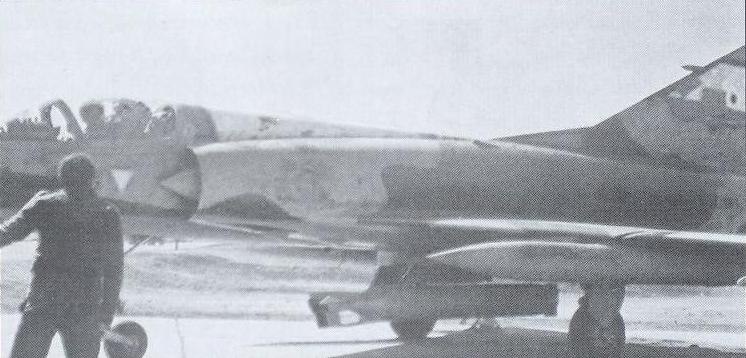 Saddam’s Flying Pharaohs: An Egyptian Mirage 5-SDE on an Iraqi airfield partaking in bombing operations against Iran in 1986. Note that the Egyptian markings have been removed (Picture Source: Cooper & Bishop, 2003, p.243). Many of the Iraqi jets, especially after 1983, were increasingly piloted by mercenary pilots of Russian, East German, Belgian, Egyptian, Pakistani and most likely French and Indian pilots. Belgian pilot Max von Rosen for example led numbers of attacks of “Iraqi” jets against Kharq Island. It is now all but certain that several downed “Iraqi” aircraft had been piloted by foreign flyers. To this day such reports are denied in the West, Egypt and Pakistan.
Saddam’s Flying Pharaohs: An Egyptian Mirage 5-SDE on an Iraqi airfield partaking in bombing operations against Iran in 1986. Note that the Egyptian markings have been removed (Picture Source: Cooper & Bishop, 2003, p.243). Many of the Iraqi jets, especially after 1983, were increasingly piloted by mercenary pilots of Russian, East German, Belgian, Egyptian, Pakistani and most likely French and Indian pilots. Belgian pilot Max von Rosen for example led numbers of attacks of “Iraqi” jets against Kharq Island. It is now all but certain that several downed “Iraqi” aircraft had been piloted by foreign flyers. To this day such reports are denied in the West, Egypt and Pakistan.
The above point must be balanced with a sobering fact. Many of the “volunteers” were uneducated and poverty-stricken in their home countries and were given financial stipends to fight the Iranians. Many others were guest workers to Iraq (i.e. Egyptian farmers) who were forcibly pressed into service for Saddam. Morale and fighting qualities were generally very low, and many of these men would simply surrender to Iranian forces. Many of Iraq’s native troops (especially Shiites, Kurds and Assyrians) also deserted regularly, not having the desire to fight against a neighboring nation against which they had no animosity.
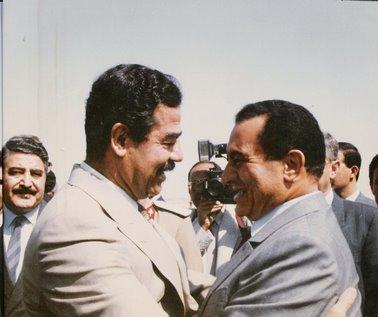 “Tanks” a Lot! Saddam Hussein and Egypt’s Hosni Mobarak. Egypt supplied Saddam with its top fighter pilots and gave Iraq much military assistance, transferring to the Iraqi army much of its Soviet-era equipment, including tanks. By 1987-1988, Egypt, Iraq and Argentina were jointly developing the “Condor” ballistic missile.
“Tanks” a Lot! Saddam Hussein and Egypt’s Hosni Mobarak. Egypt supplied Saddam with its top fighter pilots and gave Iraq much military assistance, transferring to the Iraqi army much of its Soviet-era equipment, including tanks. By 1987-1988, Egypt, Iraq and Argentina were jointly developing the “Condor” ballistic missile.
Saddam’s invasion also aimed at permanently severing Iran’s Khuzistan’s province from Iran. Pan-Arabists have long claimed Iran’s southwest Khuzistan region as a “lost” Arab province, requiring “liberation” from the “racist Persians”.

The Father of the Iran-Iraq War? A TIME-Magazine portrait of Abdolkarim Ghassem (1914-1963) the president of Iraq from 1958-1963. Ghassem was the first Iraqi leader to lay claim to Iran’s Khuzestan province on December 18, 1959. His land claims against Iran were to be adopted by the pan-Arabist Baath Party and Saddam Hussein.
It is true that Iran’s multi-ethnic mosaic includes Arabs in Khuzistan as well as the Persian Gulf coast. Nevertheless, Khuzistan has been Iranian since the days of the founding of the Medes and the Persians. This is the region of ancient Elam (an Elamo-Dravidian people) and was also known as Persis by the Greeks. Arab migrations into southwest Persia can be traced to the time of Shapur II (309-379 AD).
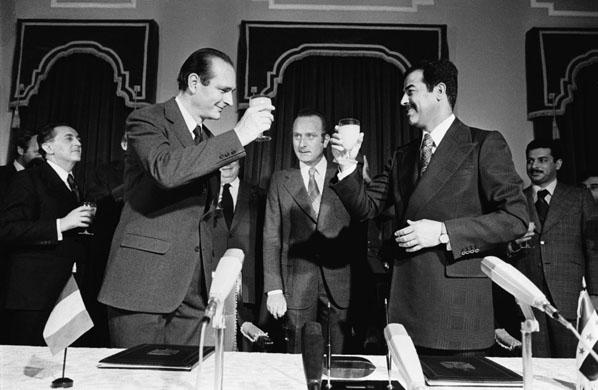 A toast to Saddam’s ambitions. Then Prime Minister Jacques Chirac of France toasts Iraq’s Saddam Hussein on December 1974. By the 1980s, France had become one of Iraq’s biggest suppliers of weapons. This support was so great that French intelligence reported in mid-1986 (after the Iranian capture of Fao) that “…if France cut off the arms pipeline to Iraq for a mere three weeks, Baghdad would collapse” (Timmerman, 1991, pp.231 – Timmerman, K.R. (1991). The Death Lobby: How the West Armed Iraq. Houghton-Mifflin Company).
A toast to Saddam’s ambitions. Then Prime Minister Jacques Chirac of France toasts Iraq’s Saddam Hussein on December 1974. By the 1980s, France had become one of Iraq’s biggest suppliers of weapons. This support was so great that French intelligence reported in mid-1986 (after the Iranian capture of Fao) that “…if France cut off the arms pipeline to Iraq for a mere three weeks, Baghdad would collapse” (Timmerman, 1991, pp.231 – Timmerman, K.R. (1991). The Death Lobby: How the West Armed Iraq. Houghton-Mifflin Company).
The Sassanians settled many Arabs inside Iran as a buffer against other marauding Arabs of the Arabian deserts. The Lakhmid Arabs were very loyal to the crown of Persia, and proved excellent warriors for the Sassanian army – a prime example is their role in support of Sassanian general Azarethes’ Savaran (elite cavalry) at Callinicum in 531. At Callinicum, the Lakhmid leader Al-Mundhir supported the Savaran’s left wing, an action which helped defeat the Romano-Byzantine general Belisarius – in AD. Khuzistanis can be described in a variety of ways: Arab speaking Iranians, Iranisized Arabs, Iranian-Arabs, etc. The fact remains that Khuzistan has been an integral part of Persia since antiquity.
The enemy of my enemy is my friend – and then my enemy. Video of Donald Rumsfeld (Special envy of President Ronald Reagan) shaking hands with President Saddam Hussein on December 20, 1983 (see also report by Norm Dixon: How Reagan Armed Saddam with Chemical Weapons). Rumsfeld was then to be one of the most vociferous advocates of removing Saddam by force in 2003.
Pan-Arabist hopes were dashed when the Arabs of Khuzistan resisted Saddam Hussein’s invasion of Iran in 1980; very few (reportedly less than 500) joined Saddam’s men. Although not known by many Iranians, the Arabs of Khuzistan fought very bravely for Iran. Saddam believed that the Khuzistani Arabs would rise up and take over the cities themselves on behalf of his army. Note the following quote by Dilip Hiro (The Longest War: The Iran-Iraq Military Conflict, London, Paladin Books, 1990, p.43):
“Patriotism engulfed the (Iranian) military…and civilians – including the Khuzistani Arabs…instead of being welcomed as liberators by Khuzistani Arabs – the majority community in Khorramshahr and Abadan – as the Iraqi forces had been led to believe, they found themselves facing spirited resistance.”
To the dismay of pan-Arabists, the Khuzistani Arabs fought against Saddam from the start of the invasion, giving the Iranian army precious time to re-organize and counterattack. It is worth noting that only 200 of the defenders of the city of Khorramshahr were professional soldiers – the rest were locals of the city – many of them local Arabs. Together with the Iranian army personnel, they literally fought to the last man. The Khuzistan Arabs, like their Lakhmid ancestors at Callinicum, remained faithful to their nation. Note photo below of Iranian Arabs preparing to fight Saddam Hussein’s invasion forces in the early 1980s; the man with the beret is a professional soldier from the Iranian army teaching the Khuzestan Arabs in the use of rocket launchers:
[Click photo to Enlarge] Iranian-Arabs being trained in the use of rocket launcher by an Iranian commando. Iranian Arabs were to later provide assistance to the Iranian army in the ejection of Saddam Hussein’s troops from Khuzestan in 1982.
It was these same Khuzistani Arabs who again fought alongside the Iranian army when the city of Khorramshahr was liberated from Saddam’s occupation in 1981. Unfazed by this failure (and rejection from the Khuzistanis), the pan-Arabists continue to advocate for the separation of Khuzistan from the rest of Iran. Click icon below for more information:
The above icon-link for the pan-Arabist website “Al-Ahwaz” which now demands that in addition to Khuzestan, all Iranian provinces (i.e. Azarbaijan, Kurdistan, etc.) separate from Iran. Pan-Arabists also support terrorist actions against civilians.
Despite the fact that Iranian Arabs rejected Baathist pan-Arabism, the Al-Ahwaz movement continues its propaganda. The movement is apparently stationed in London and there are now many members who are former Baathists of iraqi origin often pretending to be Iranian-Arabs.
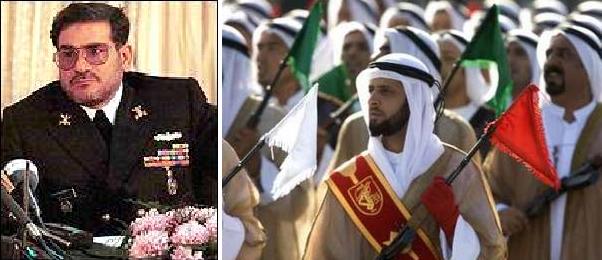 Iranian Arabs provided vital assistance to the Iranian army in ejecting Saddam Hussein’s troops from Khuzestan in 1982. One of Iran`s most important military officials is Ali Shamkhani (at left, as Iran`s Defense Minister in 2001), an Iranian-Arab who also fought in the war against Saddam Hussein`s invasion. The right photo shows an Iranian-Arab veteran contingent participating in a military parade in Tehran alongside the Iranian army after the war. Iranian Arab resistance was one of the major factors which foiled Baathist plans to conquer Iran.
Iranian Arabs provided vital assistance to the Iranian army in ejecting Saddam Hussein’s troops from Khuzestan in 1982. One of Iran`s most important military officials is Ali Shamkhani (at left, as Iran`s Defense Minister in 2001), an Iranian-Arab who also fought in the war against Saddam Hussein`s invasion. The right photo shows an Iranian-Arab veteran contingent participating in a military parade in Tehran alongside the Iranian army after the war. Iranian Arab resistance was one of the major factors which foiled Baathist plans to conquer Iran.
More than two decades after its defeat and ejection from Iranian Khuzestan, the mantle of Baathist pan-Arabist propaganda remains supported by Western lobbies (see for example Western governments supporting separatist movements…).
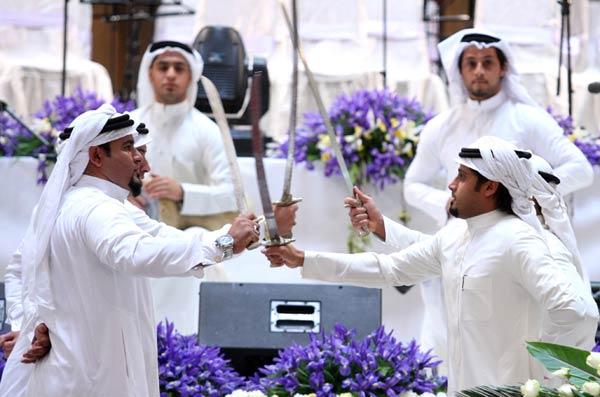 Iranian Arabs perform their tradional Arab sword-dance while partaking in Nowruz celebrations in Iran on March 21, 2013.
Iranian Arabs perform their tradional Arab sword-dance while partaking in Nowruz celebrations in Iran on March 21, 2013.
Iran has been a multi-varied and diverse nation since its inception thousands of years ago. Efforts by European powers to divide Iran along ethnic lines is nothing new. Tsarist Russia, the pan-Turkist Musavats of the Caucasus and the Soviet Union, all tried and failed to use the “ethnic card” to destroy the Iranian state. The failure to learn from history is leading contemporary Western lobbies to commit the same error that Saddam Hussein made with respect to Iran’s Khuzestan province.
[Click to Enlarge] A snapshot of Iranian diversity (Picture Source: –آواهای سرزمین من-): From right to left are an Iranian-Arab, a Turkic-speaking Qashqai, a Bakhtiari-Lur and another Iranian Arab. Despite their defeat in Iran, pan-Arabists and their Western patrons (mainly based in London) have yet to appreciate the reasons for their failures.
The tragedy of the Iran-Iraq war can be partly attributed to the Al-Husri and Sami Shawkat education philosophies dating to the 1920-1940s – these have done much to found Arab animosity against Iran. The Belgrave-Owen “Arab Gulf” invention (and their disciples such as Pridham, Rice or Olson) is undoubtedly another factor that continues to inflame Arab feelings against Persia. In my humble opinion, Belgrave and Owen are also responsible for the catastrophic loss of life and property suffered by both sides in the Iran-Iraq war.
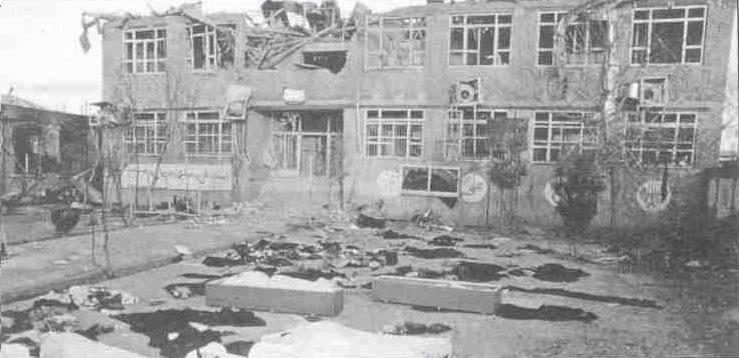 The result of an Iraqi air raid against a children’s school in Mianeh, Azarbaijan (northwest Iran) in 1988, killing more than 60 children and teachers. This horrific event was ignored by the Western press which was pro Saddam Hussein at the time (Picture source: Cooper, T. & Bishop, F. (2004). Iranian F-14 Tomcat Units in Combat. Oxford: Osprey Publishing).
The result of an Iraqi air raid against a children’s school in Mianeh, Azarbaijan (northwest Iran) in 1988, killing more than 60 children and teachers. This horrific event was ignored by the Western press which was pro Saddam Hussein at the time (Picture source: Cooper, T. & Bishop, F. (2004). Iranian F-14 Tomcat Units in Combat. Oxford: Osprey Publishing).
It is indeed tragic that the western world failed to see the dangers of pan-Arabism espoused by Saddam Hussein during that war, especially when he repeatedly used poison gas against Iranian troops and civilian centers, as well as his own helpless Kurdish Iraqi population. Instead as noted by the aforementioned Margolis (Sunday, January, 19, 2004):
“Who supplied “Chemical Ali” (Saddam’s cousin Al-Majid – see photo) with his mustard and nerve gas? Why, the West, of course. In late 1990, I discovered four British technicians in Baghdad who told me they had been “seconded” to Iraq by Britain’s ministry of defense and MI6 intelligence to make chemical and biological weapons, including anthrax, Q-fever and plague, at a secret laboratory at Salman Pak”.

Chemical Ali (Al Majid), one of the chief architects of the Baathist regime’s chemical weapons programs. Eric margolis has noted of the role of Western nations in helping Saddam Hussein develop non-conventional weapons.
As noted previously by Margolis, Western governments played a major role in arming Saddam Hussein with both conventional and non-conventional weaponry.
[Click photo to Enlarge] An Iraqi T-55 training with an advanced British-manufactured tank gunnery simulator in 1987. Iraq’s armoured corps had undergone a massive training and rearmament program by 1987-1988 – thanks to the the assistance of the Soviet Union and the Eastern Bloc, Egypt, India, Pakistan, England and numbers of Western countries (Picture Source: Armed Forces journal, July 1987 , pp.354; see also Farrokh, Iran at War, 2011, pp.400-402). British military personnel also refurbished and re-activated captured Iranian Chieftains for Saddam Hussein’s forces. For more on the role of England in supporting Saddam Hussein’s military machine, click here…
To this day, few speak of the atrocities committed on Iranian civilians by Saddam’s troops. Atrocities against Iraqi civilians or Kuwaitis are only mentioned due to current political expediency. Twenty-two years after the Iran-Iraq war, the international cmmunity must break the silence on this issue.
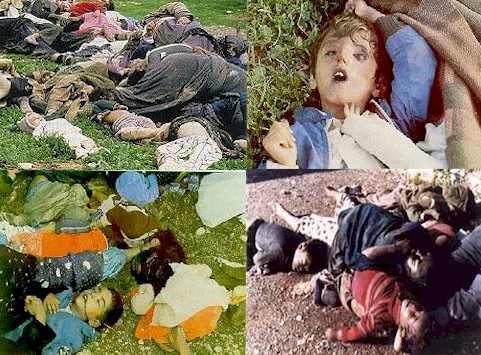 Iraqi-Kurdish victims of Saddam’s chemical weapons attacks at Halabja in 1988. Many Iranian (and Iraqi Kurdish) civilians and soldiers were subjected to chemical weapon attacks during the war. Despite the brutal rapacity of these actions, Western lobbies continued to support Saddam Hussein right up to 1990.
Iraqi-Kurdish victims of Saddam’s chemical weapons attacks at Halabja in 1988. Many Iranian (and Iraqi Kurdish) civilians and soldiers were subjected to chemical weapon attacks during the war. Despite the brutal rapacity of these actions, Western lobbies continued to support Saddam Hussein right up to 1990.
A vivid case of Persophobia was the late Osama Bin laden (1957-2011), a man who openly despised Iran and Persian culture. Before the Taliban were ejected from power by the US following the tragedy of 9/11, Bin laden practically ruled Afghanistan as his personal caliphate. Bin laden made vigorous efforts to stamp out Persian culture (i.e. Persian language, music, the Nowruz, etc.). This attitude has been adopted by many of Bin Laden’s non-Arab followers in Pakistan where his supporters frequently shout “Death to Iran” during their regular anti-western rallies. Many in the western world misconceive the late Bin Laden as a religious fanatic; he was in fact a racist in the tradition of Mr. Satia Al-Husri, Sami Shawkat and Khairallah Tulfah. His less than exemplary treatment of Persian speakers in Afghanistan has been well documented.
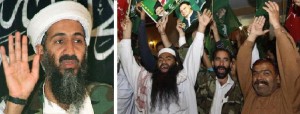 The late Osama bin Laden (1957-2011) (left) and his supporters in Pakistan (right) who continue to regard him as a hero. Before his ouster from Afghanistan, Bin Laden had turned the country into his own anti-Persian mini-Caliphate. Among his draconian Persophobic laws were bans on the use of the Persian language, Persianate musical instruments and the Nowruz (Iranian New Year). His mentors in Pakistan and India have gone so far as to insist that the Iranian word for Goodbye or “Khoda-Hafez” now be re-defined as “Allah-Hafez”. Bin Laden’s’ followers in Pakistan often shout “Death to Iran” during their regular anti-Western rallies.
The late Osama bin Laden (1957-2011) (left) and his supporters in Pakistan (right) who continue to regard him as a hero. Before his ouster from Afghanistan, Bin Laden had turned the country into his own anti-Persian mini-Caliphate. Among his draconian Persophobic laws were bans on the use of the Persian language, Persianate musical instruments and the Nowruz (Iranian New Year). His mentors in Pakistan and India have gone so far as to insist that the Iranian word for Goodbye or “Khoda-Hafez” now be re-defined as “Allah-Hafez”. Bin Laden’s’ followers in Pakistan often shout “Death to Iran” during their regular anti-Western rallies.
The extent of the Taliban’s anti-Persian mindset is aptly summarized by the Tajikam website:
“…anti-Persianism in Afghanistan continued through the Taliban era. The Taliban torched Persian books and closed Universities which used the Persian language. There were reports that the Taliban would go to libraries and bookstores and demand all books in the Persian language and they would burn them in front of the booksellers or Librarians. They beat anyone whom they heard speaking Persian and they blew up the Buddha statues which symbolized the rich history of the region…They had Persian professors replaced in Kabul University …while banning all the Persian words.”
Interestingly, the Western press, media outlets and Human Rights platforms in the West have remained generally silent with respect to the Taliban’s pan-Arabist anti-Persian policies.
Having observed the dangers of pan-Arab chauvinism, let us not forget the dangers of racist attitudes among Iranians. It is unfortunate that a growing number of Iranians, incensed by over 60 years of pan-Arabist rhetoric, Talibanism and blatant racism, have resorted to their own version of anti-Arab chauvinism. Bigotry is a human trait and has the potential to unfold within any human being (myself as writer of this article included) and must be vigorously crushed.
These attitudes ignore one very important fact: many of today’s Arabs virulently oppose Arab chauvinism. These include the aforementioned Samir el-Khalil as well the late George Hourani. Samir el-Khalil has attacked pan-Arab chauvinism and reminds Arabs of the legacy of Persia in their culture as well as in Islam. Khalil was for years a hunted man by the Saddam Hussein regime. The late Arab scholar, George Hourani, not only appreciated the Iranians for their role in helping the Arabs form their civilization, but was rigorous against politically motivated attempts to re-name the Persian Gulf as the “Arab Gulf”. Many Iraqis have dismantled Saddam’s anti-Iran propaganda props from their streets and monuments after the US invasion – this was done in order to destroy Saddam’s legacy of hate against Persia. This must be applauded by the Iranians.
Calm discourse and education are the best weapons – the pen is truly mightier than the sword. The Arab world and Iran have a great deal to offer each other – not to mention Turkey, a nation with strong ties to Iran, culturally and ethnically. No matter how hard the disciples of Satia al-Husri, Sami Shawkat, Sir Charles Belgrave or Roderick Owen may try, a calm examination of historical archives (and common sense) will confirm the legitimacy of Persia’s past (like that of Greece, Rome, India, Europe, the Arabs, the Turks and China) and the importance of appreciating her.
Historical Revisionism and Persophobic Policies of the Former Soviet Union and its Communist and Separatist Clients
- Soviet De-Iranization policies in the Caucasus and Central Asia (2008)
- –نقش امپراتوری روسیه در قطع ارتباطهای ایران و قفقاز–
- –محمد امین رسول زاده،«پیامبر » هزار چهرهً تجزیه طلبان آذری تبار را بشناسیم–دکتر کاظم رنجبر-Dr. Kazem Ranjbar (Sociologist): Understanding Mohammad Amin Rasulzadeh, the 1000 faced “prophet” of Azari separatists – see also article on Rasulzadeh and the Musavats in Lezgistan website –
- A response by the late Professor Abbas Zaryab Khoi to the Magazine “Azerbaijan” (published by Ferqeyeh Democract) (pdf file) – Abbas Zaryab Khoi, Ayandeh Magazine, Esfand Maah (February-March), 1324 (1945), pages 780-781. (Iran) – Original Persian with Translation at: (www.archive.org)
- حزب توده: گفت وگو با دآتر حميد احمدى و آاوه بيات درباره اسناد تازه فرقه دموآرات-The Tudeh Party: Discussion with Dr. Hamid Ahmadi and Kaveh Bayat regarding new revealed documnents of the Ferqeh Demokrat Party (in Persian) (pdf)
- Former Communists of Bulgaria: removing references of the Iranian legacy of Bulgarians (video)
- Response to pan-Turkist Falsification of numbers regarding the downfall of Ferqeh
On-Line Book
- Pan-Turanism takes aim at Azarbaijan (2005). Also posted at UN Association in Geneva. Note Citations of book also made in academic venues. See a peer-reviewed analysis of Kaveh Farrokh’s book: Reza Saberi-Review of Kaveh Farrokh Pan-Turanism Takes Aim at Azerbaijan-The Persian Book Review: A Quarterly on Arts and Literature, Winter 2005-2006, Volume XV Number 46, pages 89-95. See also review by Reza Saberi in Iranboom site: -معرفی کتاب پانتورانیسم آذربایجان را هدف میگیرد– (see news release of The Persian Blog Review).
Interview of Yusef Amiri (http://asvaran.blogspot.com) with Kaveh Farrokh (کاوه فرخ) on the history of promoting Persophobia, separatism and pan-Turkism against Iran
- –سوال اول:- نقش امپراتوری روسیه در قطع ارتباط های ایران و قفقاز–Question 1: Discuss Imperial Russia’s programs to sever the ties of the Caucasus with Iran
- –سوال دوم: واکنش ایرانیان به جداشدن قفقاز چه بود-Question 2: What was the Iranians’ Reaction to Severing of the Caucasus?
- Question 3: How and when did the myth of a “North Azarbaijan” versus “South Azarbaijan” first originate?
- Question 4: Describe the Ideology, Founders and Objectives of Pan-Turkism.
- Question 5: Was the Ferqeh Democrat and Jaafar Pishevari’s movement in 1946 Pan-Turkist?
- Question 6: What is the role of the Government of Baku in Promoting Pan-Turkism?
- Question 7: Why are Western Governments Silent with respect to Pan-Turkism?
- Question 8: How are Iranians themselves Promoting Persophobia, Pan-Turkism and Separatism?
Iranian Azerbaijanis Opposed to Pan-Turkism
- Book Review: Azerbaijan: Ethnicity and the Struggle for Power in Iran (by Dr. Touraj Atabaki) (2003)
- Azarbaijan, Arran and the Azarbaijani Language (in Persian): This aticle is by Dr. Nosratollah Jahanshahlou Afshar (ex-member of the pro-Soviet 1946 Pishevari Movement)
- Iranian-Azarbaijani popular singer-guitarist, Kourosh Yaghmai, sings Khake Vatan (“Soil of the Fatherland” in mp3) against the Stalnist-sponsored separatist movement of Azarbaijan in 1945-1946.
- Iranian Azarbaijanis claim Republic of Azarbaijan (former Arrna province and various Khanates) as lost Iranian province
- Various Postings and E-Mails by Kaveh Farrokh
- Videos of Iranian Azarbaijanis opposed to Pan-Turkism
- Short video of Iranian roots of Azarbaijan
- –پانترکها، راهزنانی فرصتطلب–
- The Azari Mihandoost Website
Pan-Turkism: Revising History, Language and Literature
Works of Rouben Galichian (Publications & Interviews)
- Rouben Galichian (2010). Azerbaijan, Armenia and the Showcasing of Imagination (second, revised and expanded edition). London/Yerevan: Gomitas Institute & Printinfo Art Books. ISBN: 978-1-903656-86-0. (pdf)
- Book review and analysis by Farrokh, K. (2013) on Rouben Galichian, The Clash of Histories in the South Caucasus. Iran Nameh, 28:4 (Winter), pp. 160-167. -فرخ, کاوه (1392). برخورد تاریخها در قفقاز جنوبی، بازنگاری نقشههای آذربایجان، ارمنستان و ایران. سال بیست و هشتم، شماره ۴، زمستان ۱۳۹۲ –
- Rouben Galichian interview on how the Republic of Azerbaijan falsifies history (May 19, 2014)
- Press TV interview on Galichian book “The Clash of Histories in the South Caucasus: Redrawing the Maps of Armenia, Azerbaijan and Iran“ (July 20, 2014)
- Galichian: Resource for Maps and Historical References for the Southern Caucasus
School and University Textbooks in the Republic of Azerbaijan
Cyrus the Great
- Attacks and Vandalism against the Legacy of Cyrus the Great (Updated January 18, 2009)
- Farda News: –توهین به کورش کبیر در دانشگاه تبریز-Insulting Cyrus the Great in Tabriz (in Persian)
- Pan-Turk Ideology versus Cyrus the Great: Retort by Dariush Kiani (In Persian text only; Added July 5, 2009)
- –مرگ کورش بزرگ و پانترکسیم-Pan-Turkism and Cyrus the Great (in Persian)
- Reza Moradi Qiasabadi – رضا مرادی غیاث آبادی-: (pan-Turk academic in Iranian Studies who supports pan-Turkism): -هجوم مغول ویرانگرتر بود یا هجوم کورش؟- The onslaught of the Mongol conqueror or Cyrus the destroyer? – رنجهای بشری-The sufferings of humanity– See sample of Qiasabadi’s pan-Turkist beliefs in this pan-Turk site – Note how Qiasabadi praises the anti-Semite conspiracy theorist Nasser Pourpirar – see critical response to this revisionist in Persian –منشور کورش و ماجرای سرقت رضا مرادی غیاث آبادی-The Cyrus Cylinder and the thievery actions of Reza Moradi Qiasabadi
Nizami Ganjavi
- Lornejad, S., & Doostzadeh, A. (2012). On the Modern Politicization of the Persian poet Nizami Ganjavi. Yerevan Series for Oriental Studies (Volume I), Edited by Garnik S. Asatrian. Yerevan: Caucasian Centre for Iranian Studies. (pdf) – NOTE: This is the Official Digitized Version by Victoria Arakelova; with errata fixed from the print edition.
- Azargoshnasp-نظامی گنجوی و پاسخهایی به پانترکیستها-Nezami-ye Ganjei and responses to pan-Turkist falsifications-
- –دیوان ترکی نظامی گنجوی کشف ادبی قرن یا دروغ و تحریف بزرگ قرن-The Turkish Divan of Nizami Ganjavi: the biggest literary discovery of the century or the biggest forgery of the century?
- Baku to replace Persian-inscribed tiles at Nezami mausoleum (September, 12, 2013)
Rumi
- مولانا و ادعاهای پان ترکیستان– A Study on the cultural and ethnic associations of the Persian poet Rumi and examination of some recent forgeries (in Persian by Azargoshnasp)
- Pan-Turks and a single verse by Molana — (in Persian by Shahrbaraz) -پانترکان و یک رباعی از مولانا–
- A Study about the Persian Cultural Legacy and Background of the Sufi Mystics Shams Tabrizi and Jalal al-Din Rumi (in pdf by Rahgozari Minootalab)
- -توهین به نظامی و مولوی و دهخدا چگونه مجوز گرفته و حمایت شده است؟- How have insults against Molavi (Rumi), Nezami and Dehkhoda been Officially Promoted and Protected?(in Persian)
- – پاسخی به مقاله «مولانا ترک است و فقط چند روزی از خاک ایران رد شده»– Pesponse to the claim that “Mowlana is a Turk and only passed through Iran for a few days” (in Persian)
- Bahram Shahnazar: Notes on Rumi’s Iranian Origins
Abu Ali Sina and Bahmayar
Abu Rayhan e Biruni
- بوریحان بیرونی خورازمی و تمدن خواری پان ترکیسم -Abu-Reihan e Biruni, Khwarazmi and pan-Turkists (in Persian)
Nozhat ol Majales
- The Nozhat ol Majales: A major document proving the Persian legacy of Azarbaijan – see article by Shahrbaraz in Persian – معرفی نزهه المجالس – by Shahrbaraz
- Original textbook of document available at: Nozhat ol Majles (in pdf).
Shahname
- دو دروغ پانترکیستها در مورد شاهنامه-Responding to Two Pan-Turk Fabrications regarding the Shahname (in Persian)
Babak Khorramdin
- بابک خرمدین و پانتركیسم -Babak Khorramdin and pan-Turkist claims (in persian)
- Azargoshnasp: Babak Khorramdin and pan-Turks
- Sahar News Service: Building the Statue of Babak Khorramdin in Baku, Another movement to falsify the History
Shah Ismail
Shahrbaraz Blog: The Republic of Azerbaijan (former Arran) and the Vatican
Language family Studies
- Language family Studies and Pan-Turkist manipulaiton –پان ترکیستها و دروغی به نام «اقوام همریشه التصاقی زبان»! – (in Persian)
- Disproving claims of Parthian being Turkish (2003)
- This article is by Professor G.R.F. Assar: Response to a webpage claiming the Parthian language as ancient Turkish
Politicization of the term “Turan”
The Ancient Game of Polo
Books by writers promoting pan-Turkism
- Mohammad Taqi Zehtabi (a member of Pishevari’s pro-Soviet movement in 1946) wrote: Tarikh e Direen e Torkan e Iran
[The Ancient History of the Turks of Iran]. This book routinely falsifies references and relies on pan-Turk and Soviet-era literature to revise history. Download this book in 13 parts in pdf: Zehtabi-01, Zehtabi-02, Zehtabi-03, Zehtabi-04, Zehtabi-05, Zehtabi-06, Zehtabi-07, Zehtabi-08, Zehtabi-09, Zehtabi-10, Zehtabi-11, Zehtabi-12, Zehtabi-13.
- Victor A. Shnirelman (2001): ‘The value of the Past: Myths, Identity and Politics in Transcaucasia’, Osaka: National Musuem of Ethnology.(pdf)
- Pan Turkism and Iran (in Persian) by Kaveh Bayat (pdf)
- Rustam Kamravan: Questioning Pan-Turk Claims
- Responses to Pan-Turkist manipulation of Statistics (pdf)
- ریشههای ایران ستیزی پان ترکیستها در ایران-The Roots of Pan-Turkist anti-Persianism in Iran (in Persian)
- سوسکها و پان ترکیستها –The Cockroach issue(in Persian)
- A German Reference to Pan-Turkism (March 17, 2009)
- Ahmad Kasravi: Role of Mohammad Ali Shah Qajar in Promoting Ethnic Conflicts between Persian and Tukic Speakers –روایت احمد کسروی از تلاش محمدعلی شاه برای راه انداختن دعوای ترک وفارس –
- Ehsan Shaghasemi and Bijan Tafazol (2011). Intercultural Demonization on the Web: A Qualitative Approach to the Iranian Blog Sphere (pdf)). International Conference on Conflict, Terrorism and Society: Societies Unde Siege Proceedings, Kadir Has University, Istanbul, Turkey, pp.125-131.
- –پانترکیسم، خطر جدی برای ایرانیتباران و راهکاری برای مقابله با آن– Pan-Turkism a serious threat for Iranians and ways of confronting it.
- –برای حفظ تمدن قوم ایرانی ، ایرانیان زیر ستم پانترکیسم را نجات دهیم-Saving Iranians chafing under the oppresion of pan-Turkism
- –نويسنده: تارا فرهید -سخنى چند در باره جستار ستم ملى -Tara Farhid: A Discussion regarding alleged “National Injustices”
- Iranian Roots of Azarbaijan (Video)
Pan-Turkism in Central Asia and the Caucasus
- The Axed Persian Identity: Part I by the now defunct Tajikestanweb.com – available in Persian: کیستی تبرخوردهی زبان پارسی
- تاجيکان ازبکستان-The Tajiks of Uzbekistan (in Persian)
- پان تورکیست های اوزبیک، خطرناک تر از فاشیست های اوغان -Uzbek Pan-Turks: More Dangerous than the Fascists of Oghan:(in Persian)-by www.tajikam.com
- Attack on a Lezgian Mosque by www.Farda.us See also “Ethnic repressions against Lezgians“
- – افشاگري عالمانه در مبارزه دايم و بي امان با جريان شوم پانتركيسم – تات ها – Pan-Turkism against the Tats of the Caucasus (in Persian)
Western Media articles on Pan-Turkism
- New York Times (1936): Turks teach new Theories
- The Canadian Jewish News (March 6, 2009): Jews must Reject Turkey’s Genocide Denial
Iranian Media articles on Pan-Turkism and the dangers of Separatism (in Persian)
- Tabnak News (April 25, 2009):The background on the role of Baku in promoting the Balkanization of Iran
- Tabnak News (April 25, 2009): The Case of Daghestan
- Noor Portal News Service: National integrity the threat of ethnic seperatism
- Video (in Persian) by Iranian youth Mehran Zormehr warning against Internal Conflict in Iran (posted June 25, 2009)
- Turkish Prime minister declares Ibn Sina (Avicenna), Khwarazmi, and Farabi as Turks (reported in Persian by Balatarin News Service) and in Turkish by the Hurriyet newspaper on September 24, 2009). Consult also Analysis by Shahrbaraz in Persian
- Talishistan TV
- Lezgistan TV (In Russian – English translator in site)
- –تالش زمین Taleshzamin толышыстон–
- Taleshon
Pan-Turk Activists: Spreading Racialist Propaganda and Engaging in Vandalism
- The case of Mr. Hossein Seddiq: نخستين حركتهاي شوروي در ايران-[ The first Soviet movements in Iran], –حسین محمد زاده صدیق را بیشتر بشناسیم [Familiarizing with Mr. Hossein Seddiq] –نگاهی به مانیفیست جدید پان ترکیسم [A Look at the new Manifesto of pan-Turkism].
Other pan-Turk activists
- The Persphobia of Mehran Bahari
- Javad Heyat: Baku’s man in Tehran
- Tohid Malekzadeh Damghani: Pan-Turkist in Iran’s Ministry of Education
Pan-Turks in Action in Iran (Videos)
- The Coackroach cartoon Incident – protests of May 22, 2006 (video)
- Demonstration in Tabriz University (May 22, 2008) (video)
- Pan-Turks in Soccer Stadiums in the year 2010 (video) – see also An Eye-Witness Account of Pan-Turk Racism during Soccer Game in Tabriz in this Persian penned article (December 9, 2010).
- Anti-Iran Pan-Turk Racialists in Tehran Azadi Stadium Chanting “Arab Gulf” August 27, 2010 (video)
- Separatist and pan-Turk rallies in Urumiah in February (2009 ) (video)
- Pan-Turks attempt to incite hatred against Iranian-Armenians (2011) (video)
- Pan-Turks in soccer stadium in Tabriz (2013) (video)
- Racist and Persophobic Pan-Turk videos (WARNING: Disturbing Content)
Western politicians promoting Balkanization
- Letter to Congressman Dana Rohrabacher Regarding Azarbaijan (September, 1, 2012)
- Italian parliament holds hearing from ethno-separatists -سخنرانی دکتر صدیقه عدالتی در پارلمان ایتالیا–
- Congresswoman Jane Harmon retracts Statement regarding Iran “Separation” Statements (posted May 22, 2009). Letter by Nader Paymai to Congresswoman Jane Harman (May 28, 2009).
Turkey and the role of pan-Turkism
- Article in October 31, 2010 issue of Foreign Affairs-Special Analysis journal which outlines the rising role of pan-Turkism in Turkey and the challenges for Iran.
- Today’s Zaman: Iranian Azeris set up national council in Turkey, aspire for Independence
Ad Hominem attacks by Pan-Turks Against Kaveh Farrokh
- Pan-Turkist insults Kaveh farrokh in Persian and Turkish (June 26, 2012)
- Rude pan-Turkist attacks against Kaveh Farrokh (November 1, 2011)
- Pan-Turkist Amin Jaafari of Iran Security Forces threatens Kaveh Farrokh (October 25, 2011)
- Racist E-Mail from a Pan-Turk named Mr. Attila (September 11, 2010)
- Ad Hominem attacks against Farrokh by pan-Turk activists and interview request (August 13, 2009)
- E-mail from “Kemal” in Baku (June 18, 2009)
Racism of Tehranists, Persian Chauvenists and Aryanists
- Eliminate demeaning ethnic jokes –جوک های قومیتی را ممنوع کنیم (Facebook)
- Danyal Lotfi: The Negative Impact of Racist Jokes
- Persian Chauvenist’s attacks against Kaveh Farrokh
- Bahram Moshiri: Dangers of Iranian Aryanism
Intellectuals Thinkers
The iranian Left and Communist organizations
Dr. Parviz Rajabi’s assertions against Iran’s Persian Legacy and pre-Islamic Persia
- When Iranian Professors attack their own History: The case of Dr. Parviz Rajabi. By Kourosh Ahmadi & Shahyar Mahabadi.
- مروري بر سقوط ساسانيان و ورود اسلا – available in pdf – NOTE: In this interview Dr. Rajabi (1) questions the legacy of the Sassanians (2) defends the article of Spiegel Magazine which attacked Cyrus the Great and his legacy of human rights and (3) criticizes Iranians for reacting to the movie 300. For further information regarding Dr. Rajabi’s views, consult Dr. Rajabi’s blog.م
- پاسخی بر سخنان دکتر پرویز رجبی در مصاحبه با روزنامه اعتماد – available in pdf – Dr. Rajabi insults the Zoroastrian community and responses by Ardeshir Khorshidian (available in pdf in Persian).
- واكنش اردشير خورشيديان، فرنشين انجمن موبدان تهران به گفتوگوي اعتماد با پرويز رجبي:
ناراست نشان دادن ايرانباستان، نتايج شومي دارد - پرویز رجبی و سقوط ساسانیان–Shahrbaraz Blog–available in pdf –Dr. Rajabi’s views on the reasons for the fall of the Sassanian empire.
- Dr Dariush Akbarzadeh defends Cyrus the Great against Parviz Rajabi and Historical Revisionists
Attempts at Governmental Level to Re-write History of Iran
- World Tribune: Re-Writing the History of Iran
- The Extreme Religious Right and the Muslim Brotherhood (Ikhwan al Moslemeen)
- Opportunistic Elements with the Iranian Establishment
- Rewriting High School History Books in Iran –تحریف تاریخ در کتاب دوم راهنمایی–
- –نامه به وزیر امور خارجه -Complaint letter by Dr. Houshang Tale to Iranian officials regarding distortion of history (October 10, 2011)
- –تاریخنگاری «اسلامی» و شاهان ایران -“Islamic” historiography and the kings of Iran
Re-writing History Books in Iran
- Censorship & Rewriting High School History books (in Persian)-سانسور گسترده ای در کتاب های تاریخی
- BBC Report in Persian: The elimination of the history of pre-Islamic monarchs of Persia in Iran’s history books –حذف پادشاهان از کتب تاریخ مدارس ایران-See also Radio farda report.
- Concerns raised with Ministry of Education of Iran and Historiography of Iran
Religious clerics and Officials attacking History and Culture of Ancient Iran
- The late Ayatollah Motaheri: attacking ancient Iranian culture and calling all who celebrate ancient Iranian culture as “Idiots” .
- Top Iranian leaders demand that statue displays of ancient (Achaemenid) Persia be removed in book and cultural fair
- –پاسخی مستدل به ادعاهای ناقشنگ شیخ صادق خلخالی -Response to the late Sadegh Khalkhali’s assertions against Cyrus the Great-ادعای واهی لواط کار بودن کوروش کبیر از سوی دشمنان ایران-Attacks against the Legacy of Cyrus the Great
Iranian Officials using pan-Arab terminology against the name of Persian Gulf
- Iranian Chief of Morality Police using pan-Arabist terminology against the Persian Gulf-جعل نام خلیج فارس توسط رئیس پلیس امنیت اخلاقی ایران–
- Sentiments against Ancient Iran and the Persian Gulf by Government Officials
Iranian Officials and Ethnic issues
- Are Segments within the IRI encouraging Ethnic Separatism? (Aya Bakhshi az Jomhuriyeh Eslaami az Tajziyeh Talabaan Qowmi Poshtibanani Mikonand?)
- Iranian religious cleric inciting up racial hatred against Iran’s Afghani community – fails to mention that Afghans and Iranians share the same heritage. language, literature and culture
- وزارت اموزش و پرورش و تغییر تاریخ ایرانیان
Various Iranian Writers of the 1960s-1970s and the Present
- Idealistic Iranian Writers and Academics
- Animosity against Iranian Culture: The Case of Ahmad Shamloo (By Ali Sajjadi in Persian text only; in pdf format).
Tehranism, Neglect of Iran’s Diverse regions and anti-Provincial Chauvinism
- Dr. Touraj Atabaki (2005), Ethnic Diversity and Territorial Integrity of Iran: Domestic Harmony and Regional Challenges, Iranian Studies, volume 38, number 1, March 2005, pp.24-44. (pdf)
- Nayareh, Tohidi, (29 June 2006), Iran: Regionalism, Ethnicity and Democracy, Open Democracy: Free Thinking for the World (pdf)
- Eliminate demeaning ethnic jokes —جوک های قومیتی را ممنوع کنیم (Facebook)
- Danyal Lotfi: The Negative Impact of Racist Jokes
Consult also: Endangered Archaeological Sites

